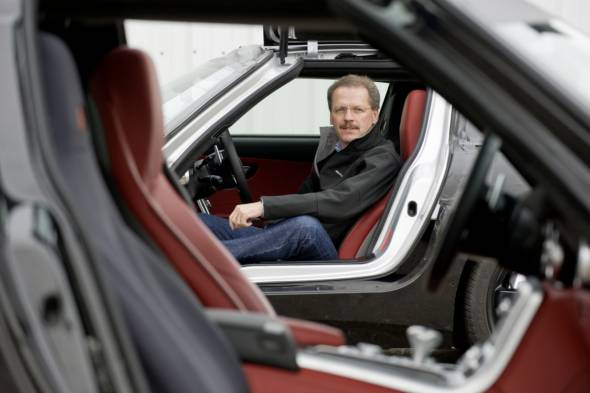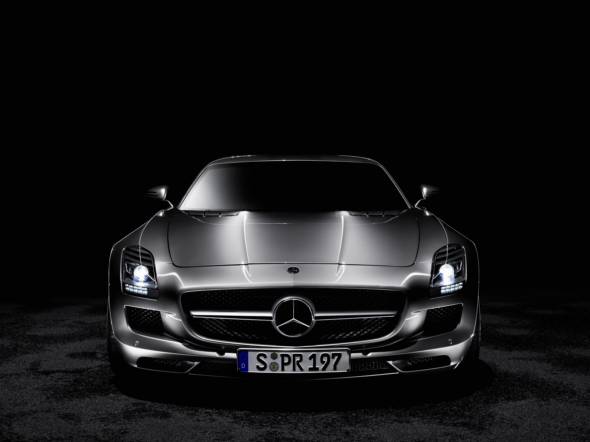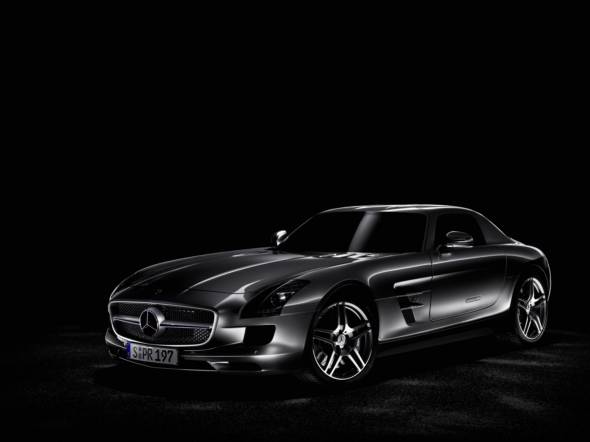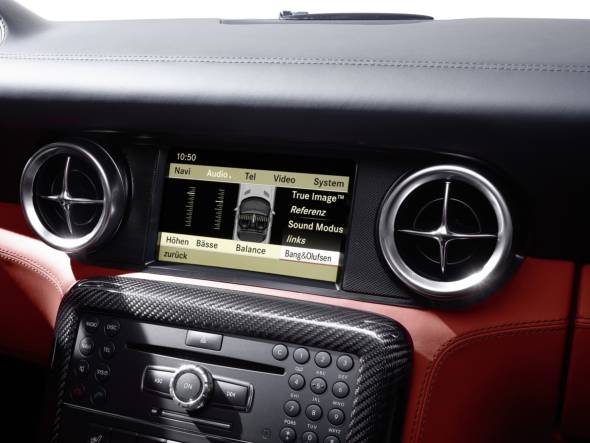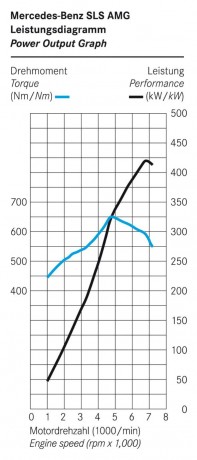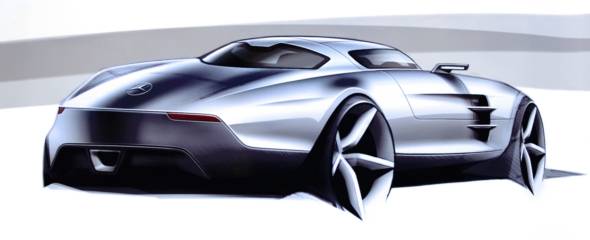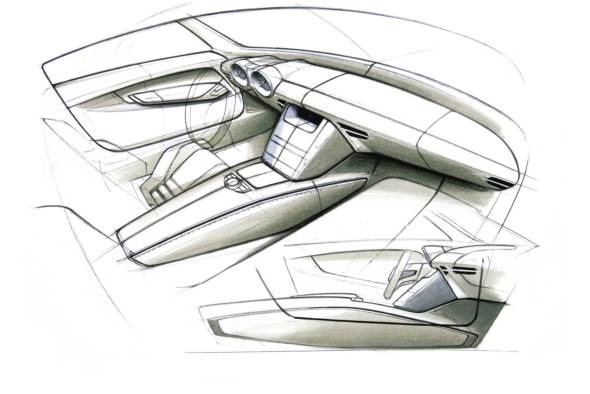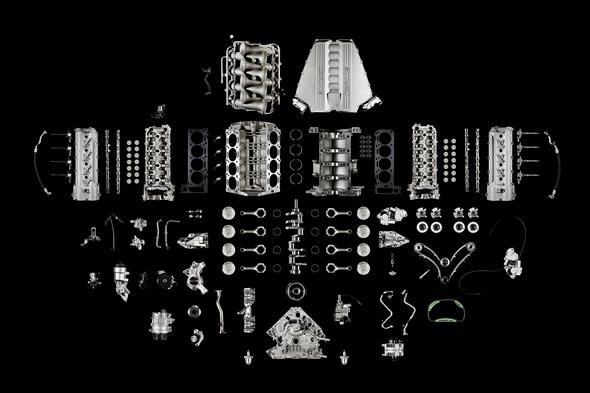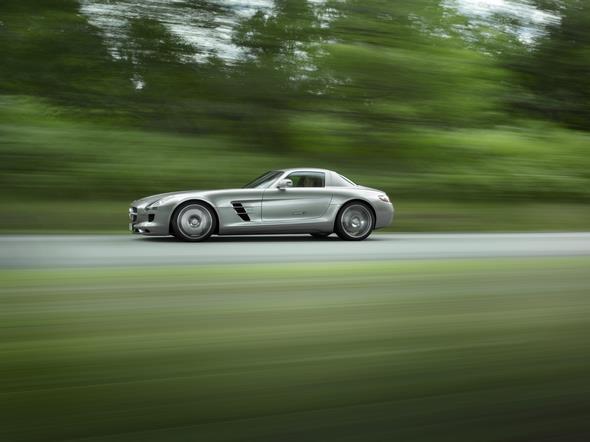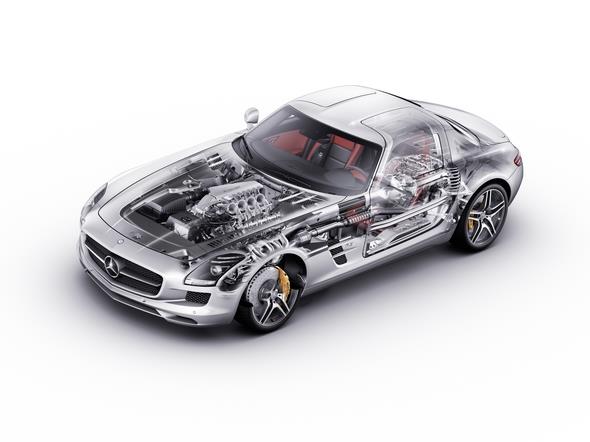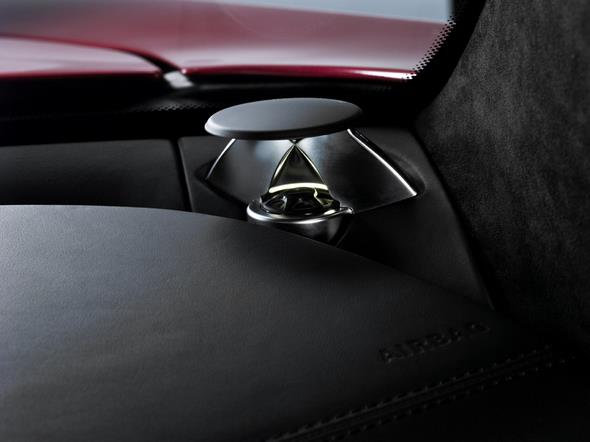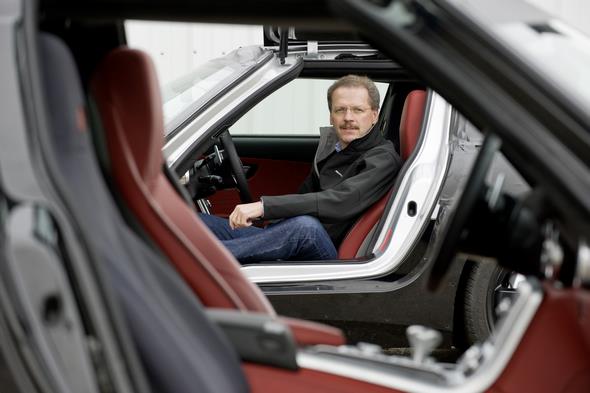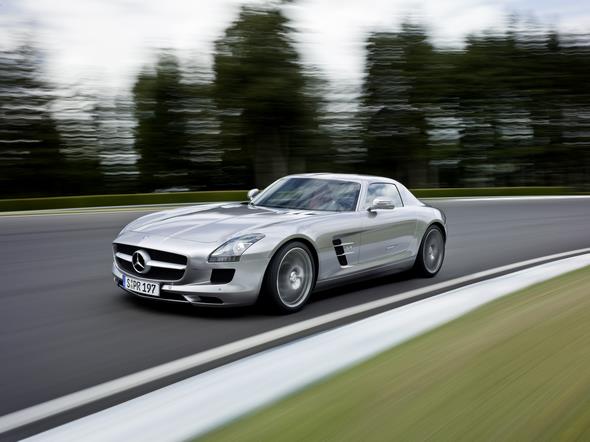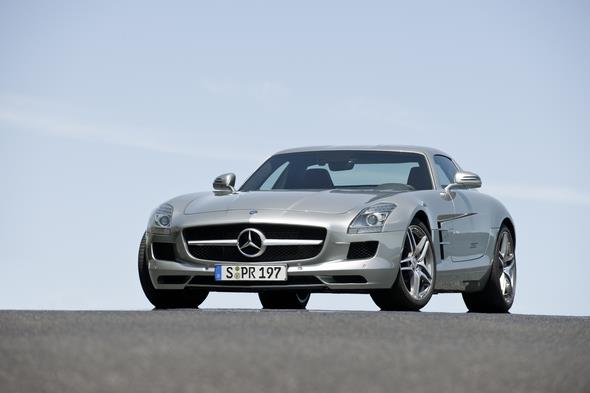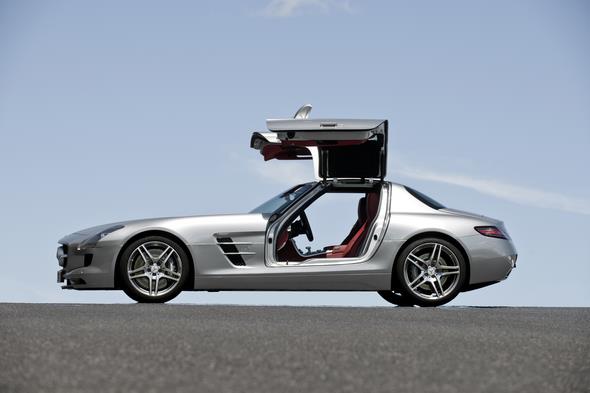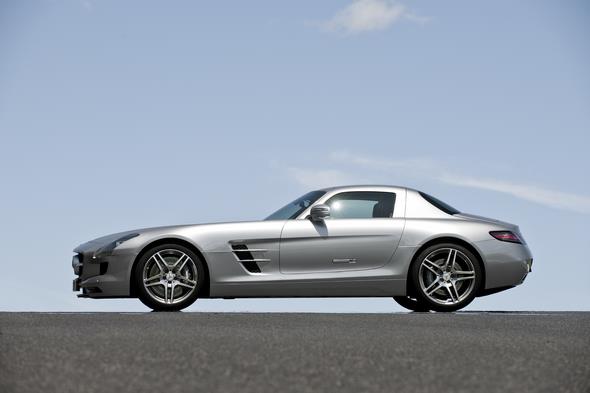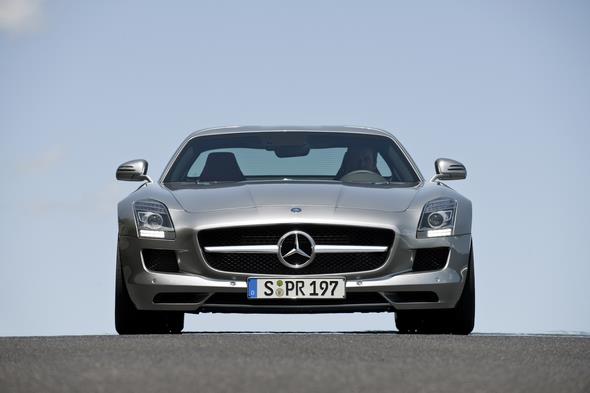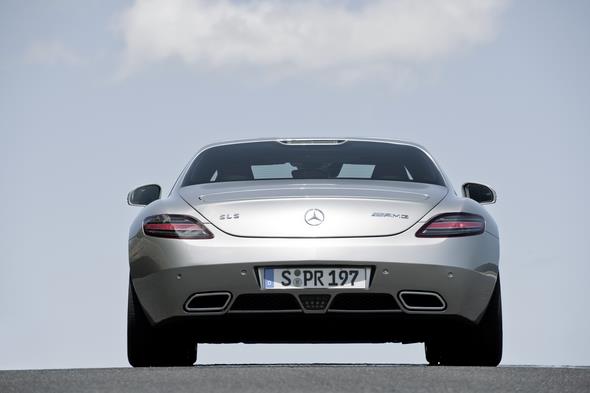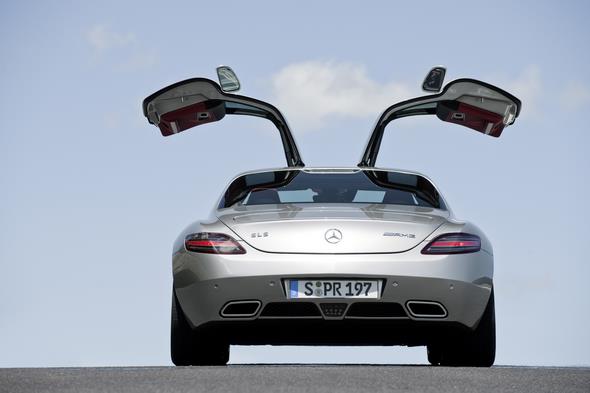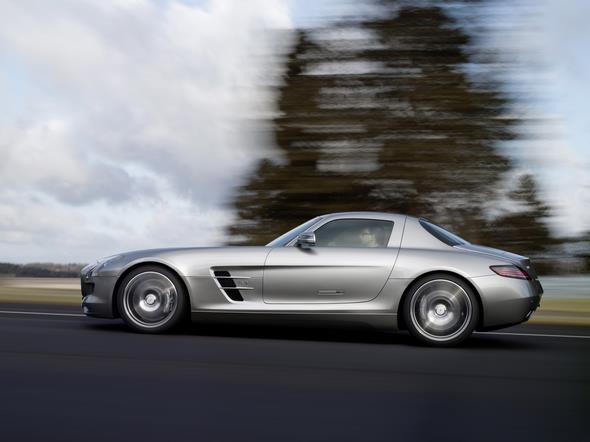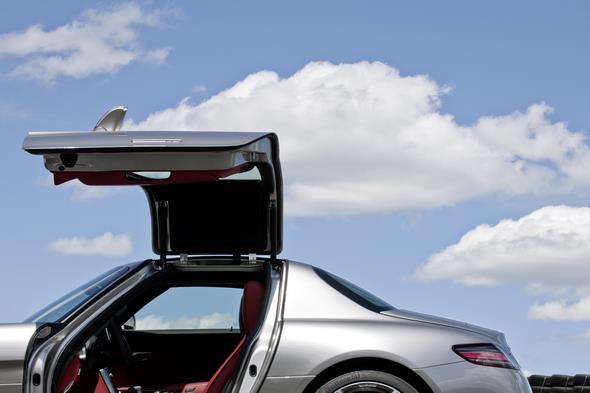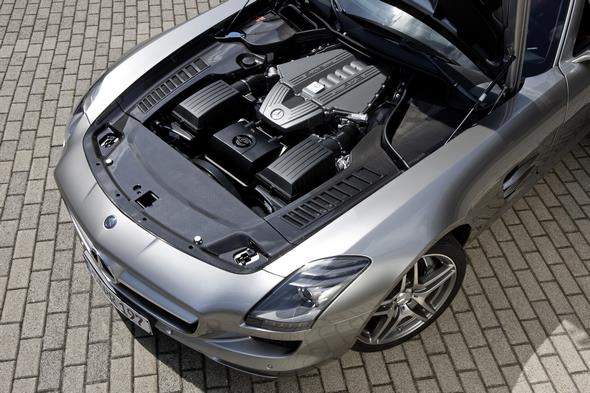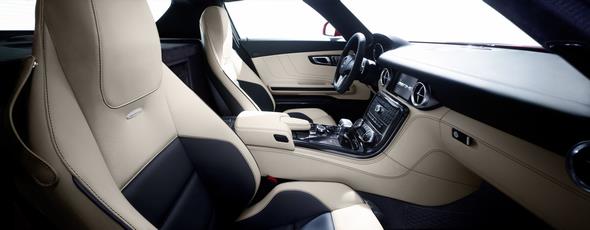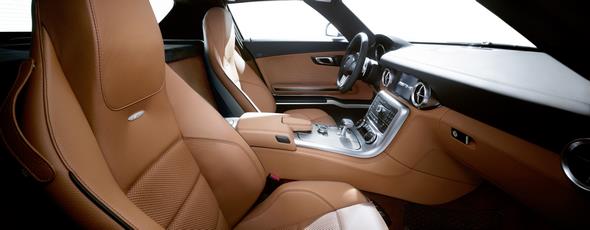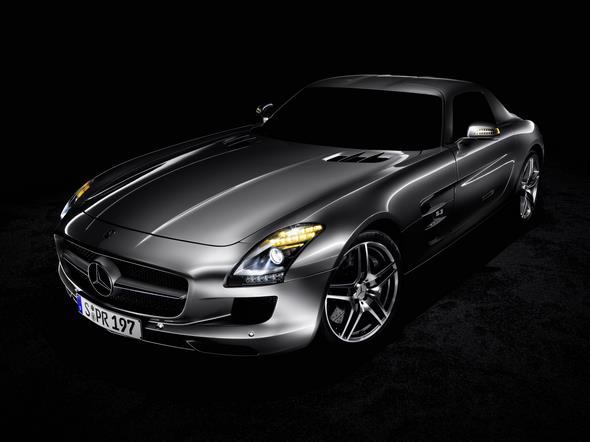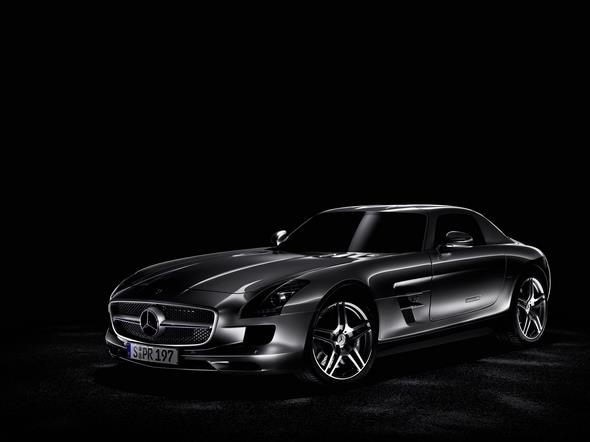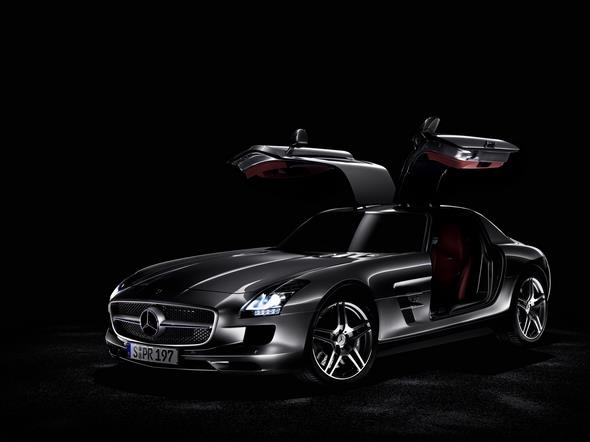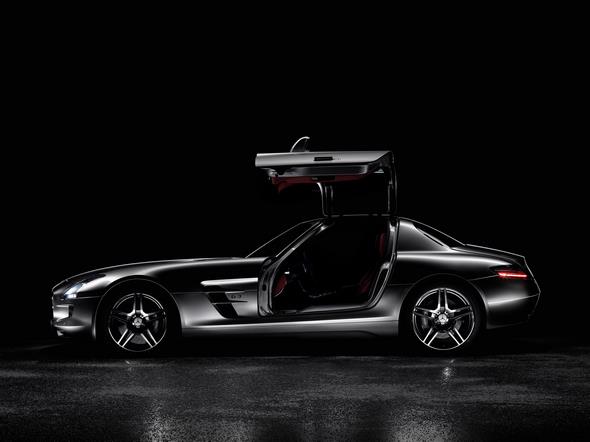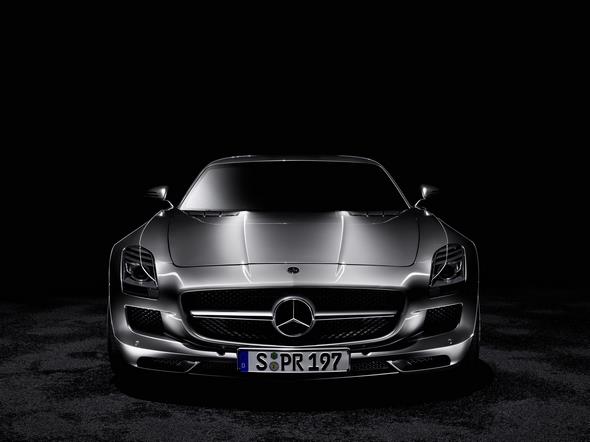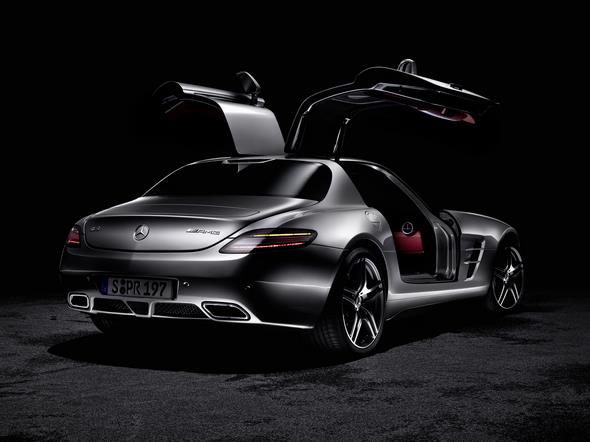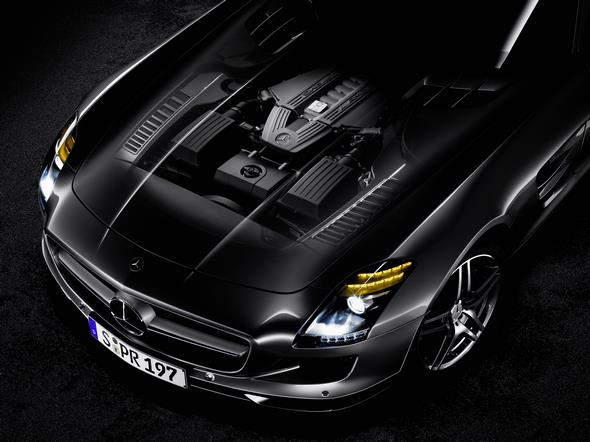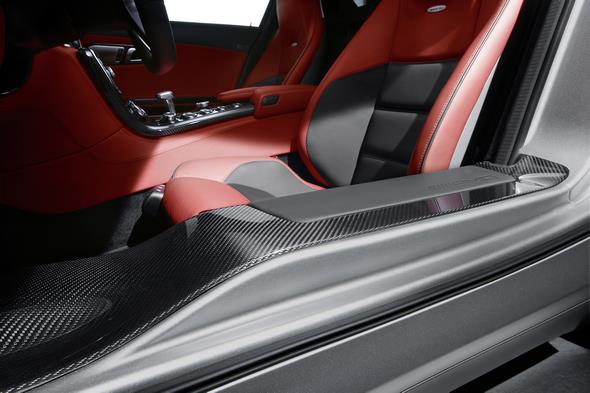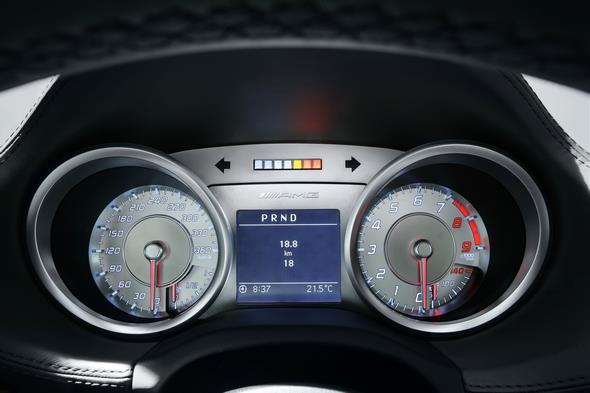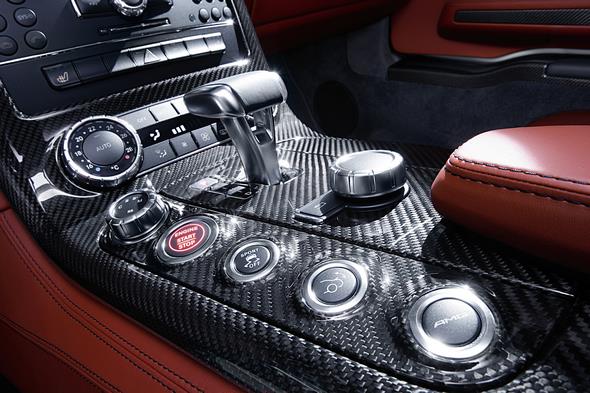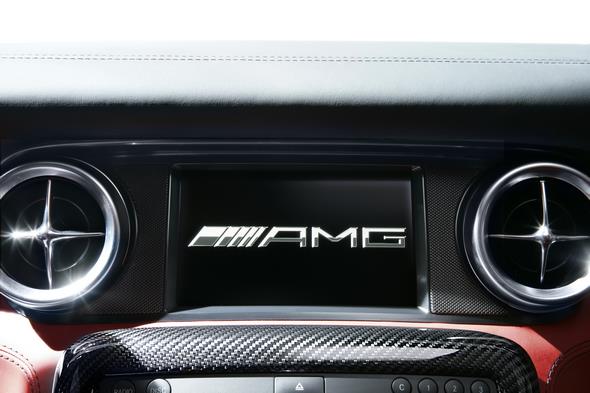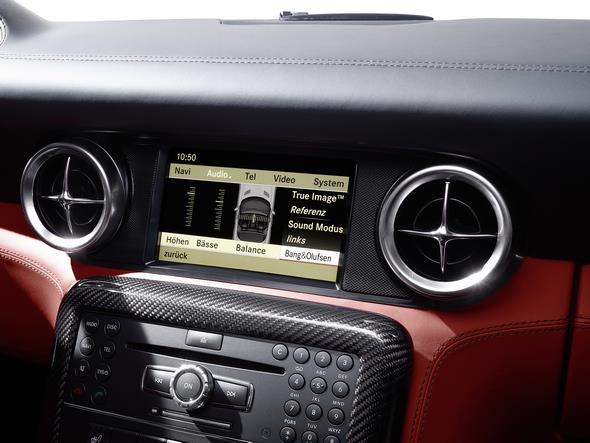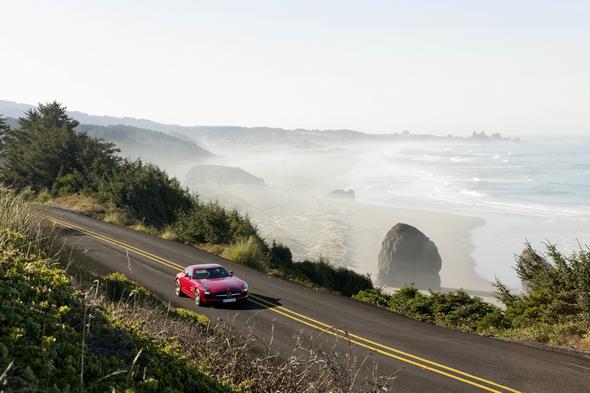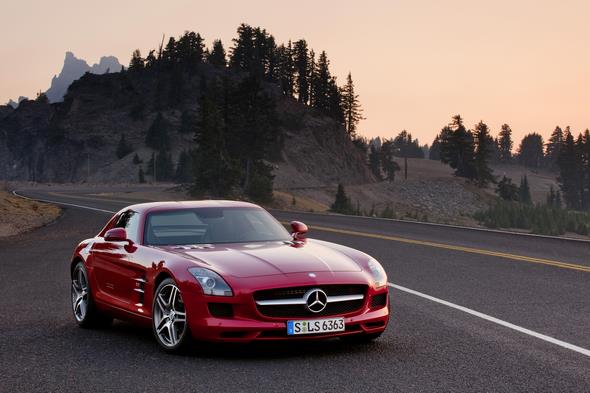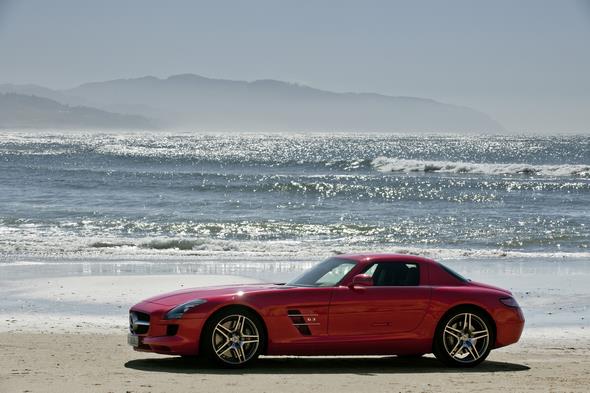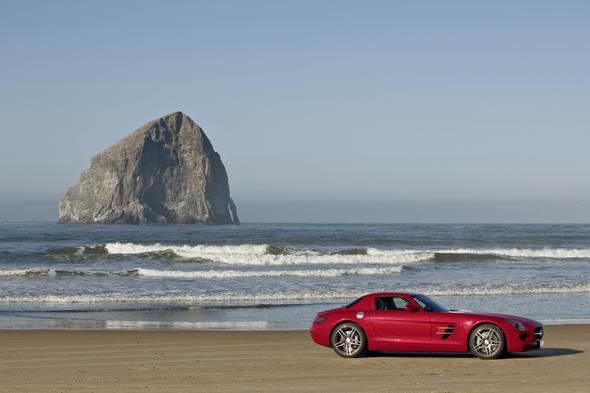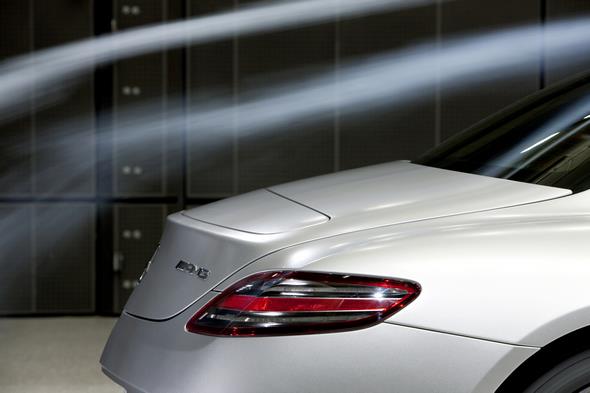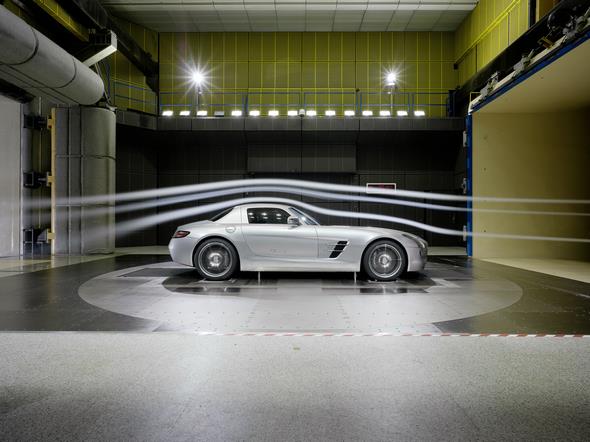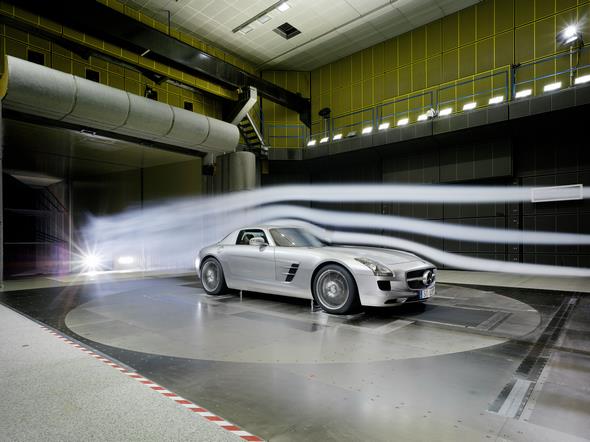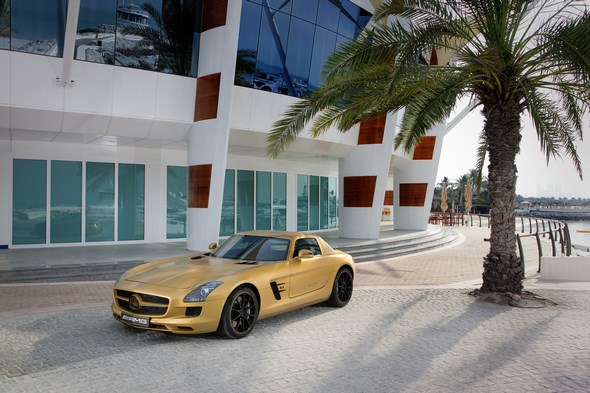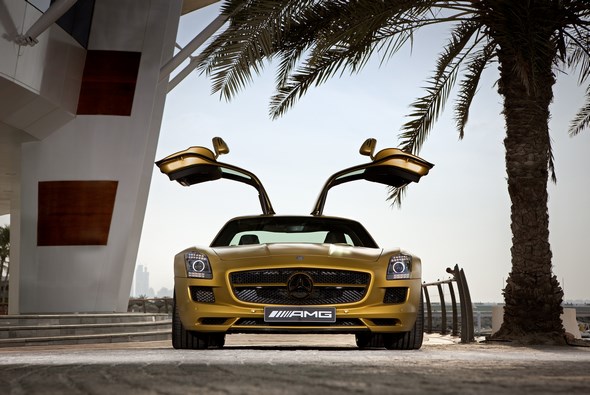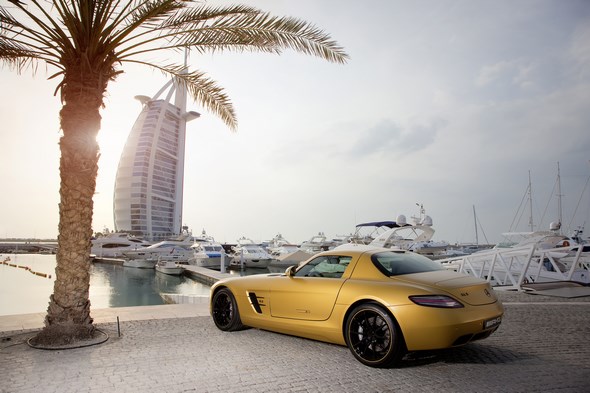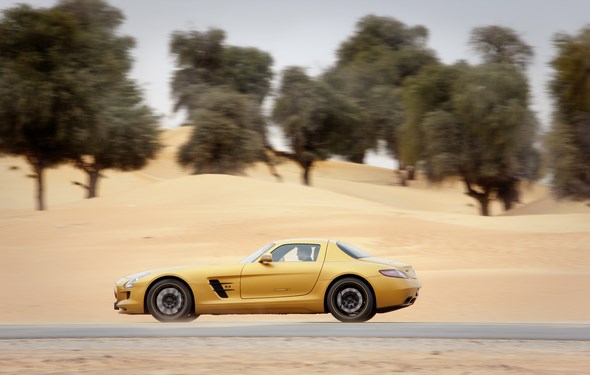Mercedes C197 SLS AMG 2009-

There are some of those rare beauties you will seldom lay your eyes upon. Certainly the Mercedes Benz CLS 197 is one of them.
This luxury grand tourer automobile was initially launched to replace the Mercedes Benz McLaren model.
The car was designed to undertake long distances with minimal hurdles to the traveler.

Hence the name Grand Tourer or ‘Gran Tourismo’ This car is the first automobile designed in house for Mercedes by AMG.
The car made a huge impact when it was first projected in the Frankfurt Auto Show in 2009.
So popularity did the car receive that it has been decided to be the cover car for the Play Station 3 game “Gran Tourismo series five”.

Even though the vehicle has still not been presented for sale in the market, it is expected to be available by the middle of 2011 in the United States of America.

The SLS AMG has a unique design with a long bonnet and short rear. Instead of normal doors, it has winged doors that open upwards manually.
The passenger compartment is placed near the rear axle. The car has been designed in four versions, first being the one with gullwing doors.
The second one is the ‘Desert Gold Version’. The third and the fourth are the soon to come? electricity driven and Black series? respectively.

Highly capable, the SLS AMG has an accelerating capacity of zero to hundred in just about four seconds and has a maximum speed of 200 miles per hour.
It applies carbon ceramic disk brakes and uses minimal carbon emissive fuel in consideration with the norms laid by International Automobile Federation.

In order to make the ride safer the Mercedes Corporation has gone one-step further.
The car sports a rear wing, which pops up to provide stability during high speeding or applying brakes.
This car can be a dream come true experience for any Mercedes lover and certainly others.

Stuttgart/Affalterbach – The new Mercedes-Benz SLS AMG, which is about to celebrate its world premiere on 15 September 2009 at the International Motor Show (IAA) in Frankfurt/Main, embodies a blend of consummate automotive fascination and high tech.
The super sports car delivers a compelling mix of purist styling, consistent lightweight design and superior driving dynamics.
At the same time, the SLS fully lives up to all the expectations of hallmark Mercedes everyday practicality and optimum safety.
In essence, the new ‘Gullwing’ offers the ideal synthesis of the strengths of Mercedes-Benz and AMG.

The new super sports car from Mercedes-Benz and AMG makes for an alluring proposition with its unrivalled technology package: aluminium spaceframe body with gullwing doors, AMG 6.3-litre V8 front-mid engine developing 420 kW/ 571 hp peak output, 650 Nm of torque and dry sump lubrication, seven-speed dual-clutch transmission in a transaxle configuration, sports suspension with aluminium double wishbones and a kerb weight of 1620 kilograms based on the DIN standard – this superlative combination guarantees driving dynamics of the highest order.

The ideal front/rear weight distribution of 47 to 53 percent and the vehicle’s low centre of gravity are testimony to the uncompromising sports car concept.
The ‘Gullwing’ accelerates from 0 to 100 km/h in 3.8 seconds, before going on to a top speed of 317 km/h (electronically limited).

The fuel consumption of 13.2 litres per 100 kilometres (combined) puts it at the front of the competitive field (all figures provisional).

“Mercedes-Benz is presenting an exhilarating super sports car in the guise of the new SLS AMG, which is bound to set the pulses of all car enthusiasts racing that extra bit faster.

The brands Mercedes-Benz and AMG have joined forces to create the SLS AMG – which is set to become one of the most alluring sports cars of all time”, says Dr. Dieter Zetsche, Chairman of the Board of Management of Daimler AG and Head of Mercedes-Benz Cars.

“Our customers will experience with the SLS AMG the expertise of Mercedes-AMG, built up over 40 years of motor racing.
The unrivalled technology package delivers outstanding driving dynamics coupled with moderate fuel consumption figures – part and parcel of the modern-day AMG,” says Volker Mornhinweg, Chairman of Mercedes-AMG GmbH.

“The styling of the new Mercedes-Benz SLS AMG is not only very special because of the exclusive gullwing doors.
Our aspiration is to utilise this interpretation to create the classic of tomorrow and roll out the most alluring sports car of the 21st century.

Our aim is also to create a new design icon, which shapes the incomparable legend of our brand, alongside Mercedes models like the CLS or the SL.
At the same time, the new SLS paves the way for the design philosophy of forthcoming Mercedes-Benz sports cars”, says Gorden Wagener, Head of Design at Mercedes-Benz Cars.

Design: purist, distinctive and passionate
The distinctive styling of the new Mercedes-Benz SLS AMG enthrals with its passionate sportiness and reinterprets the breathtaking lines of the Mercedes-Benz 300 SL – one of the outstanding design icons of the Mercedes-Benz brand.

With its purist design the new SLS AMG reflects the philosophy of contemporary sports car engineering: the bonnet which measures just under two metres, the low greenhouse positioned well to the rear and the short rear-end with an extendable aerofoil are just as powerful a reminder of the superlative dynamism as the long wheelbase, the wide track and the large wheels.

The short overhangs feed through into the proportions, just as does the design of the super sports car with its low-slung front-mid engine set well back and dual-clutch transmission in transaxle configuration.
An undoubted styling highlight comes courtesy of the gullwing doors which lend the SLS AMG its incomparable charisma – making a unique statement in this vehicle segment.

The gullwing doors are not alone in rekindling memories of the Mercedes-Benz 300 SL; the hallmark wide radiator grille with the large Mercedes star and the wing-shaped cross fins are a throwback to the front-end of the sports car legend.
The three-dimensional, sculptured front-end with its low-set, swept-back front apron set well into the sides lends the ‘Gullwing’ its powerful stance on the road.

Six large cooling air intakes and the vertically arranged headlamps set well to the outside with their alluring inner ambience provide a dominant aura: the central bi-xenon low-beam headlamp with its metallic wing section is framed at the top by two LED indicators and the LED daytime driving lights at the bottom.

Influences from aircraft construction
Allusions to aircraft construction come courtesy of the prominent Mercedes star, whose tubular section is reminiscent of the air intake on a jet engine when viewed from the side, as well as the long bonnet: as the eye is drawn forward, so the observer becomes more aware of the curve.

The design of the four fins with their Silver Shadow finish that adorn the two air outlet grilles on the end of the bonnet create the same visual impression.
These aircraft-style lines also visually accelerate the air that flows past – and make the SLS AMG appear extremely dynamic even while stationary.

The fins on the bonnet are taken up on the vehicle flanks: the connoisseur also discovers here a hallmark styling feature of the 300 SL.
The “6.3” lettering placed between the fins provides a clear reference to the high-displacement naturally aspirated V8 engine.

The side air outlet feeds through into a stylistically prominent feature line, which together with the convex flanks and the exhilarating surface treatment, combines aesthetics with power.
The compact passenger compartment proves as alluring as it is unmistakable.

With its high beltline, low side windows and steeply angled windscreen it comes across as a kind of visor.
The forward angled B-pillar with its stylish flowing sweep to the rear window exudes pure dynamism.
Side view dominated by muscle and shoulder

Seen from the side, the eye is drawn to the prominent vehicle shoulder of the SLS, which stretches like a taut muscle from the front to the rear.
Distinctive 19-inch (front) and 20-inch (rear) light-alloy wheels fill the wheel arches, which stand out prominently from the sidewall.

Three different wheel variants all provide a glimpse of the large high-performance composite brakes.
Seen from above, a prominent, uninterrupted line runs from the muscle to the rear.
This styling feature is also picked up on the bonnet where the eye follows a distinctive contour which flows over the roof between the gullwing doors, right through to the third brake light.

Rear view that emphasises width
The rear view of the SLS also exudes dynamism and power: the gently sloping boot lid emphasises a sense of width, an impression reinforced by the prominent vehicle shoulder and the sleek tail lights: fitted with LED technology, the horizontally structured lighting units provide a scintillating view.

Wing-shaped LED lighting elements ensure a distinctive, enthralling night design. The Formula-1-style LED fog lamp/reversing light is set down low in the centre.
Similarly inspired by motor racing are the black diffuser insert and the two chromed tailpipes of the sports exhaust system.

The strikingly tapered rear apron provides an unimpeded view of the wide rear wheels, lending the ‘Gullwing’ its self-assured stance on the road.
The spoiler integrated in the boot lid is automatically deployed from a speed of 120 km/h to ensure optimum stability at high speeds.
New colours: “AMG ALU-BEAM silver” and two matt finishes

The colour charts for the SLS include nine exclusive paint finishes. The highlight comes in the shape of the unique “AMG ALU-BEAM silver” paintwork: the new, unique process makes the paint shine like liquid metal.

The paint covers the body panels like a metallic skin, emphasises the scintillating design lines of the ‘Gullwing’ more strongly than any previous paint job and makes them even livelier by means of targeted light reflections.
This effect is made possible thanks to tiny pigments measuring between 30 and 50 nanometres.

The two matt finishes “designo magno allanite grey” and “AMG magno sylvanite grey” are just as eye-catching: with their matt silk surface they reinforce the sporty character of the two-seater through specific contouring of the crease lines.
Interior with allusions to aircraft construction and motor sports practicality

You only need to open the gullwing doors on the Mercedes-Benz SLS AMG and ease into the sports seats to experience a whole new level of interior.
The Mercedes-Benz designers took their inspiration from aircraft construction when styling the interior – immediately bringing an aircraft cockpit to mind.

The characteristic styling feature is the dashboard, whose powerful and dramatic wing shape makes for an impression of width.
Strikingly integrated into the dashboard are the galvanised air vents with their adjustable, cruciform nozzles and Silver Shadow finish – their shape reminiscent of a jet’s engines.

The instrument cluster with its LED upshift indicator and two white backlit dial instruments add another decidedly sporty touch with their metallic Silver Shadow finish.
The silver dials have red needles and a 360 km/h speedometer scale. As a central feature of the cockpit, the COMAND APS multimedia system with its 7-inch screen is integrated between the two centre air vents.
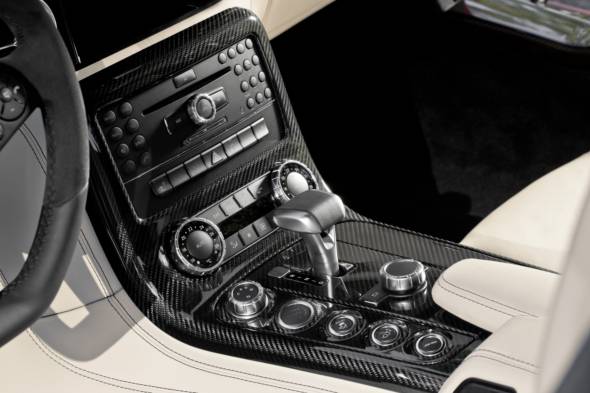
The elongated centre console in matt metal similarly picks up on the design theme of the aircraft cockpit.
It is home to the AMG DRIVE UNIT, which is inclined towards the SLS driver and allows them to choose their very own vehicle setup.

The E-SELECT shift lever, whose styling recalls the thrust control of a jet, controls the AMG SPEEDSHIFT DCT 7-speed sports transmission.
All the controls are made out of solid metal, with a high-sheen Silver Shadow surface.



The concave inner panels of the gullwing doors, the high beltline and the powerful side sill panels round off the cockpit-like impression, while imparting a feeling of sports car-like ergonomics.
Fine materials such as nappa leather, solid metal and (optional) genuine carbon-fibre facings underline the pronounced “custom-built” nature of the SLS interior, and show enormous attention to detail.

Five different designo leather colours are available to meet individual preferences: black, classic red, sand, porcelain and light brown.

Wide-opening gullwing doors for easy entry
Despite the low sitting position of just 369 millimetres in typical sports car fashion, the wide-opening gullwing doors make it easy to get in and out of the vehicle.
At the design stage great attention was paid to the widest possible opening angle – it is a full 70 degrees.

Equally importantly, the distance between the open doors and the road surface is a generous 1.50 metres, while the entry aperture between the open doors and the upper edge of the door sills measures no less than 1.08 metres.

The entrance height, i.e. the distance between the road surface and the upper edge of the door sills is a very low 45 centimetres.
As another important criterion for dignified access and egress, two gas-pressure struts positioned next to the door hinges require only very little pressure when opening and closing the doors – even at very low ambient temperatures.

The gullwing doors require less opening space than conventional coupé doors, and can be fully opened in a normal garage.
The door is opened from inside by a handle finished in Silver Shadow. The grip section of the armrest moulded into the interior door panel ensures problem-free door closing.

The operating buttons for the power windows, central locking system and exterior mirror adjustment are also located in the interior door panels for easy access.
The feeling of comfortable spaciousness is in large measure due to the generous shoulder-room of 1483 millimetres and elbow room of no less than 1606 millimetres.

In conjunction with the generous maximum headroom of 990 millimetres and effective legroom for the driver of 1058 millimetres, the result is a low but extremely relaxed seating position.
At the same time the intentionally steep angle of the windscreen ensures good all-round visibility for the passengers.
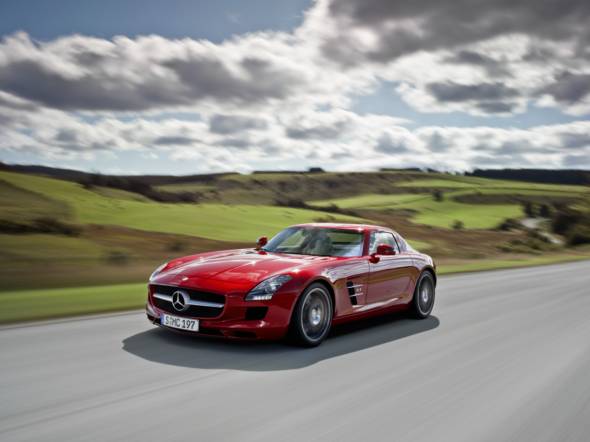
Sports seats with magnesium backrests
The sports seat backrests are made from magnesium, a high-tech material that combines light weight with high strength.
This leads to significant advantages where weight distribution and a low centre of gravity are concerned. The sports seats feature so-called two-zone seat cushions.

Prominent side bolsters with a harder foam filling provide optimal lateral support, while the inner areas of the seat cushion and backrest are softer for a high level of comfort on long journeys.
In conjunction with the Memory package (optional), the fore-and-aft position, seat height, backrest angle, squab angle and steering column are electrically adjustable; three individual settings can also be stored.

Four-way lumbar supports reliably protect the lower spine, while adjustable side bolsters in the backrests effectively improve lateral support on fast bends.
Three-stage seat heating and seat occupancy/child seat recognition in the passenger seat are also standard equipment.

The sports seats with integrated head restraints and sporty transverse fluting are upholstered in designo leather – and two-tone seats are also available in classic red, sand and porcelain.
If light brown is chosen as an interior colour, the sports seats are upholstered in natural leather with particularly high-quality woven leather on the centre seat panels.

Depending on the colour combination, fluorescent or black piping provides another sporty touch.

The Performance leather steering wheel in a three-spoke design has a 365-millimetre rim with a flattened lower section, shift paddles and a metal insert, underlining the authentic custom-built look and ensuring the best possible vehicle control.

A host of stowage space for hallmark Mercedes day-to-day suitability
The interior of the SLS AMG also impresses with the practical stowage space that makes for the day-to-day suitability typical of a Mercedes.
The 3.7-litre glove compartment with a spectacles section is integrated into the dashboard on the passenger side.
To the right of the E-SELECT shift lever there is a small stowage tray with a 12 V socket, or an ashtray with cigar lighter.

The armrest behind the centre console not only serves to operate the COMAND Controller: at the touch of a button, the armrest can be moved in two stages to reveal a stowage compartment underneath.
This has two cupholders and the telephone cradle (optional), and a holder for the ignition key in the rear section.
Other items can be stowed on the rear wall between the seats and in the parcel net in the passenger footwell.
Two fixed clothes hooks are attached to the seat backrests, while those in the roof liner fold down and are silicon-insulated.
The button to unlock the boot lid is located underneath the light switch. Alternatively the boot can be opened using the ignition key.
The luggage compartment can hold up to 176 litres. A made-to-measure luggage set is available as an option, which enables the boot space to be used to full advantage.
Overview of the comprehensive standard equipment for the SLS (selection):
- COMAND APS
- Cord floor mats with AMG logo
- Interior appointments in designo leather
- Anti-theft warning system
- Electric parking brake
- Headlamp Assist
- KEYLESS-GO start function
- PARKTRONIC
- Rain sensor
- Reversing camera
- Heated sports seats
- Sports pedals in brushed stainless steel with rubber studs
- Cruise control with SPEEDTRONIC
- THERMOTRONIC
Optional extras include the following:
- 6-disc DVD changer
- Bang & Olufsen BeoSound AMG surround sound system
- Anti-theft alarm system with tow-away protection and interior monitoring
- Interior appointments in designo single-tone Exclusive leather
- Interior appointments in designo two-tone Exclusive leather
- Interior appointments in designo Exclusive light brown natural leather/woven leather
- Paintwork “AMG ALU-BEAM silver”
- Paintwork “AMG magno sylvanite grey”
- Paintwork “designo magno allanite grey”
- Media interface
- Memory package with electric seat and steering wheel adjustment
- Performance sports steering wheel in Alcantara®/leather
The AMG Performance Studio also enables even the most discerning individual customer requirements for the SLS AMG to be met:
- Carbon-fibre exterior mirrors
- Carbon-fibre engine compartment cover
- Carbon-fibre trim (front stowage tray and rear stowage compartment incl. lid, AMG DRIVE UNIT surround, surrounds for the centre console, shiftgate and rear, trim strips for centre console and door armrests
- Interior Carbon Package (carbon-fibre trim, trim on seat backrest and side, door sill panels)
- Performance suspension with a stiffer setup for optimised lateral dynamics
- 10-spoke forged wheels
- Sports bucket seats
Aluminium spaceframe for lightweight design and outstanding strength
The SLS is also breaking the mould when it comes to the body concept: for the first time, Mercedes-Benz and AMG are presenting a car with an aluminium chassis and body.
Compared with the traditional steel design, this results in a significant weight saving, clearly illustrated in the DIN kerb weight of 1620 kilograms.

The newly developed bodyshell comprises an aluminium spaceframe. This exclusive design combines intelligent lightweight design with outstanding strength – thus delivering superlative driving dynamics.
Lightweight aluminium sections connect the force nodes to a sturdy structure.
The large, low-set cross-sections of these aluminium sections ensure high resistance torque, thus providing the required direct transfer of drive, braking and suspension forces.
The structure prevents unwanted flexibility; the vehicle responds rigidly, almost without twisting and directly.
45 percent of the intelligent, weight-optimised aluminium spaceframe is made out of aluminium sections, 31 percent out of aluminium sheet, 20 percent out of aluminium cast and 4 percent out of steel.
Maximum occupant safety requires the use of ultra-high-strength, heat-formed steel in the A-pillars.
The bodyshell weighs 241 kilograms – an absolute benchmark in the super sports car segment when compared with the peak output of 420 kW/571 hp.
Low centre of gravity and transverse reinforcing struts for superb dynamism
The entire vehicle concept has been designed to achieve a centre of gravity that is as low as possible.
This applies both to the low connection of the powertrain and axles as well as to the arrangement of the stiffness-relevant bodyshell structure, which has been kept as low as possible.
Examples include the rigid flexural and torque connections between the front and rear section and the safety passenger cell, which have been realised consistently using force paths that are as low as possible.
This results not only in a low centre of gravity but also a harmonious and, thus, efficient force path in the vehicle structure.
Another prominent feature of the lightweight construction design is the transverse reinforcing struts at the front and rear axle that are integrated into the bodyshell structure.
The sections connect the side members precisely where the highest forces act upon the bodyshell under dynamic cornering.
The advantages of this sophisticated solution include unrivalled transverse rigidity and the absence of heavy secondary stiffening or supports.

Passive safety of the very highest calibre
Naturally, the aluminium spaceframe meets all the requirements in terms of passive safety and the hallmark Mercedes-Benz body quality that applies to any car sporting the Mercedes star.
The best possible passive safety for the occupants is ensured by the standard-fit three-point seat belts, belt tensioners, belt force limiters and eight airbags: two adaptive airbags and a kneebag each are available for the driver and passenger.
Two sidebags integrated into the seats and two separate windowbags that deploy from the door waistline are also available.
Fine-tuned AMG 6.3-litre V8 engine developing 420 kW/571 hp
A powerful eight-cylinder engine manufactured by Mercedes-AMG forms the heart of the new SLS.
The fine-tuned 6.3-litre V8 engine develops 420 kW/571 hp at 6800 rpm, turning the SLS AMG into one of the most powerful sports cars in its segment.
A power-to-weight ratio of 2.84 kg/hp comes courtesy of the low vehicle weight. The naturally aspirated engine delivers maximum torque of 650 Nm at 4750 rpm.
The ‘Gullwing’ accelerates from 0 to 100 km/h in 3.8 seconds, before going on to a top speed electronically limited to 317 km/h (all figures are provisional).
Bearing the internal designation M 159, the V8 high-revving engine with its displacement of 6208 cubic centimetres has been thoroughly reengineered compared with the M 156 entry-level engine and boasts all the hallmarks of powerful racing engines.
The principal measures in increasing output include the all-new intake system, the reworked valve train and camshafts, the use of flow-optimised tubular steel headers and the de-throttling of the exhaust system.
This results in much better cylinder charging, which feeds through into an increase in output of almost nine percent.
The eight-cylinder engine responds swiftly to movements of the accelerator pedal, demonstrating much more pronounced high-revving flexibility across the entire rev range.
The switch to dry sump lubrication also translates into a much lower position of the engine in the vehicle.
And lowering the vehicle’s centre of gravity has also paved the way for high lateral acceleration and exhilarating driving dynamics.

Perfect synthesis of lightweight design and strength
The use of high-strength components compensates for the increased engine load associated with the higher output.
Forged pistons, a reinforced crankshaft bearing, optimised crankcase structure, along with improved lubrication thanks to an on‑demand high-performance oil pump ensure optimum durability.
Despite these higher loads, the engine weight for the M 159 has been further reduced.
The forged pistons as oscillating masses play a particularly valuable role in this respect, resulting in a kerb weight of 205 kilograms and, in turn, a power-to-weight ratio of 0.36 kg/hp – an unrivalled figure compared with the competition.
Sophisticated catalytic converter technology enables current and future exhaust emission standards such as EU 5, LEV 2 and ULEV to be met.
A match for demanding fuel consumption targets
Despite its uncompromisingly sporty character, the demanding fuel consumption targets have been met.
The SLS AMG consumes 13.2 litres per 100 kilometres (combined, provisional figure), earning it a place at the top of the competitor rankings.
Efficiency-enhancing measures include the familiar AMG-exclusive, friction-optimised twin-wire-arc-sprayed coating on the cylinder walls as well as the on-demand, map-optimised oil supply and intelligent generator management: during the engine’s overrun phases and braking, kinetic energy is used to charge the battery, rather than being wasted by simply generating heat.
This recuperation assists the driver not only during braking action but also helps convert the braking energy into electrical energy.
Conversely, the generator is switched to no-load operation during acceleration, thus reducing the load on the engine.

Dual-clutch transmission with transaxle configuration and torque tube
The AMG 6.3-litre V8 engine delivers its abundant power via an ultra-light carbon-fibre driveshaft at the rear axle – similar to the set-up used on the DTM C-Class racing touring car.
The dual-clutch transmission is mounted at the rear (transaxle principle) and is connected to the engine housing via a torque tube.
A carbon-fibre shaft rotates at engine speed in the torque tube. The advantages of this sophisticated solution are associated with the rigid link between the engine and trans-mission and, in turn, the optimum support for the forces and torque generated.
A new AMG SPEEDSHIFT DCT 7-speed sports transmission takes care of power transfer. The dual-clutch transmission boasts fast gear changes with no loss of tractive force – in as little as 100 milliseconds.
The driver has a choice of four different driving modes: “C” (Controlled Efficiency), “S” (Sport), “S+” (Sport plus) or “M” (Manual) along with a RACE START function.
In the Sport, Sport plus and Manual modes the automatic double-declutching function is active; all the modes can be selected conveniently via the rotary control in the AMG DRIVE UNIT.
Optimum traction comes courtesy of the mechanical differential lock, which is integrated in the compact transmission casing.
Sophisticated suspension layout with double-wishbone axles
The chosen solution with a front-mid engine plus transaxle configuration ensures an ideal front/rear weight distribution of 47 to 53 percent.
Mounting the engine behind the front axle has created the ideal conditions for consummate driving dynamics with precise steering, first-class agility, low inertia with spontaneous directional changes and outstanding traction.
The commitment of Mercedes-Benz and AMG to building an alluring super sports car that combines consummate racetrack performance with hallmark Mercedes long-distance comfort has given rise to an ingenious suspension layout.
All four wheels are located on double wishbones with a track rod, a technology that has proven itself in motor racing, right through to Formula 1.
With a double-wishbone axle, the wheel location and suspension function remain separate; the spring/damper struts are supported on the lower wishbone.
The double-wishbone concept with its high camber and track rigidity positively locates the wheel with minimal elastic movements, providing the driver with an optimum sense of road contact when driving at the limits.
Wishbones, steering knuckles and hub carriers at the front and rear are made entirely from forged aluminium – substantially reducing the unsprung masses; this configuration also notably improves the suspension response.
The long wheelbase of 2680 millimetres not only results in outstanding straight-line stability but also low wheel load shifts, significantly reducing the vehicle’s tendency to dive and squat.
The broad track width – front 1682, rear 1653 millimetres – ensures lower shifts in the wheel loads from the inner to the outer wheel when cornering, enabling the tyres to retain more grip.
The large caster angle of 11.5 degrees significantly increases negative wheel camber when cornering and also improves tyre grip – this also ensures outstanding stability when braking heavily while cornering.
Direct steering, differential lock and 3-stage ESP®

The rack-and-pinion steering gear provides a consistently direct steering feel with a constant mechanical ratio of 13.6:1, in tune with the high expectations placed on a super sports car.
The power steering provides speed-sensitive assistance and improves the feedback for the driver as the road speed increases: an indispensable factor for high-speed straight-line driving.
Mounting the steering gear in front of the engine on the integral subframe enables the engine to be set down very low.
The ‘Gullwing’ comes with 3-stage ESP® as standard, providing the driver with access to the three “ESP ON”, “ESP SPORT” and “ESP OFF” modes at the push of a button.
The result is even more driving pleasure without compromising active safety at all. In “ESP OFF” mode too, operating the brake pedal restores all the normal ESP® functions.
The system’s traction logic of the acceleration skid control system (ASR) is active in all three ESP® modes.
If one of the drive wheels starts to spin, specific brake pressure is applied to improve traction notably – especially in conjunction with the standard-fit mechanical multi-disc limited-slip differential.
This means that the engine power is transferred to the road even more effectively when driving in a particularly dynamic style.
Ceramic composite brakes, innovative flow-forming wheels
The AMG high-performance braking system with composite brake discs at the front ensures extremely short stopping distances even under enormous loads.
The newly developed, optional ceramic composite brakes with larger brake discs guarantee even better brake performance.
The ceramic brake discs will perform reliably at even higher operating temperatures thanks to their greater hardness, all combined with an impressive weight reduction of around 40 percent.
Reducing the unsprung masses has further optimised the handling of the ‘Gullwing’ – which pays dividends particularly when tackling fast bends on motorways.
Lightweight construction was also key when it came to the wheels: weight-optimised AMG light-alloy wheels – 9.5 x 19 inch (front) and 11.0 x 20 inch (rear) – based on the innovative flow-forming principle reduce the unsprung masses while increasing driving dynamics and suspension comfort.
In addition to the standard-fit AMG 7-spoke light-alloy wheels, 5-twin-spoke wheels and 10-spoke forged wheels are available as an option.
265/35 R 19 (front) and 295/30 R 20 (rear) tyres developed exclusively for the SLS AMG ensure optimum performance.
A tyre pressure monitoring system is fitted as standard to permanently monitor tyre pressure in all four wheels; individual tyres are shown on the display.

The reinterpretation of the legendary ‘Gullwing’ is scheduled to be launched in spring 2010. The sales price is (incl. 19% VAT).
More about the SLS-AMG can be found at: www.mercedes-benz.com/sls-amg
Mercedes-Benz SLS AMG
Engine
| Number of cylinders/arrangement | 8/V, 4 valves per cylinder | |
| Displacement | cc | 6208 |
| Bore x stroke | mm | 102.2 x 94.6 |
| Rated output | kW/hp | 420/571 at 6800 rpm |
| Rated torque | Nm | 650 at 4750 rpm |
| Compression ratio | 11.3 : 1 | |
| Mixture preparation | Microprocessor-controlled petrol injection, HFM |
Power transmission
| Drive system | Standard drive system | |
| Transmission | AMG SPEEDSHIFT DCT 7-speed sports transmission | |
| Ratios | Final drive |
Chassis and suspension
| Front | Aluminium double-wishbone suspension, anti-dive, coil springs, gas-pressure shock absorbers, stabiliser |
| Rear | Aluminium double-wishbone suspension, anti-squat and anti-dive, coil springs, gas-pressure shock absorbers, stabiliser |
| Braking system | Composite disc brakes, internally ventilated and perforated at the front, internally ventilated and perforated disc brakes at the rear, electric parking brake at the rear, ABS, Brake Assist, 3-stage ESP® |
| Steering | Speed-sensitive rack-and-pinion steering, steering damper |
| Wheels | Front: 9.5 J x 19; rear: 11 J x 20 |
| Tyres | Front: 265/35 R 19; rear: 295/30 R 20 |
Dimensions and weights*
| Wheelbase | mm | 2680 |
| Track, front/rear | mm | 1682/1653 |
| Overall length | mm | 4638 |
| Overall width | mm | 1939 |
| Overall height | mm | 1262 |
| Turning circle | m | 11.9 |
| Boot capacity** | l | 176 |
| Kerb weight acc. to DIN | kg | 1620 |
| Payload (basis: ready-to-drive state as defined by EC) | kg | 240 |
| Perm. gross vehicle weight | kg | 1935 |
| Tank capacity/incl. reserve | l | 85/14 |
Performance and fuel consumption*
| Acceleration 0 – 100 km/h | s | 3.8 |
| Top speed | km/h | 317*** |
| Fuel consumption, NEDC comb. | l/100 km | 13.2 |
| CO2 emissions | g/km | 314 |
* provisional figures; ** according to VDA measuring method; *** electronically limited.
Mercedes-Benz SLS AMG: high-tech and fascination
The new ‘Gullwing’ from Mercedes-Benz
Stuttgart/Affalterbach – For the first time in the company’s history stretching back over 40 years, the Mercedes-Benz performance brand is presenting a vehicle developed in-house, the Mercedes-Benz SLS AMG.
The super sports car serves up an exciting proposition with its unique technology package: aluminium spaceframe body with gullwing doors, AMG 6.3-litre V8 front-mid engine developing 420 kW/571 hp peak output and dry sump lubrication, seven-speed dual-clutch transmission in a transaxle configuration and sports suspension with aluminium double wishbones.
The ideal front/rear weight distribution of 48 to 52 percent and the vehicle’s low centre of gravity are testimony to the uncompromising sports car concept.

“Mercedes-Benz is presenting an exhilarating super sports car in the guise of the new SLS AMG, which is bound to set the pulses of all car enthusiasts racing that extra bit faster.
The SLS AMG is emotion pure and simple for the Mercedes-Benz brand and is set to become one of the most alluring sports cars of our era”, says Dr. Dieter Zetsche, Chairman of the Board of Management of Daimler AG and Head of Mercedes-Benz Cars.

“Our customers will experience with the SLS AMG the expertise of our sports car manufacturer Mercedes-AMG, built up over 40 years of motor racing, along with the kind of scintillating design that only a top athlete from the Mercedes-Benz stable can offer”, says Volker Mornhinweg, Chairman of Mercedes-AMG GmbH.
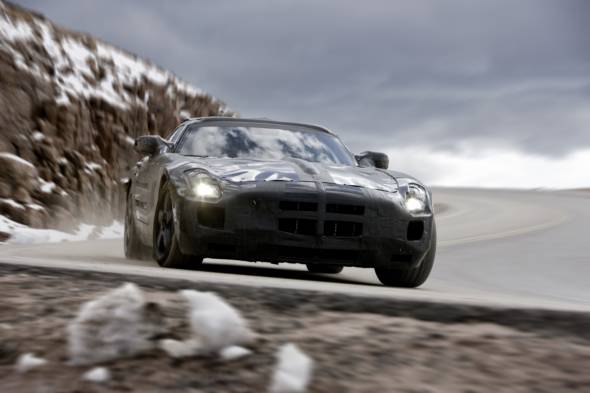
The new Mercedes-Benz SLS AMG offers purist, distinctive styling, superior driving dynamics and hallmark Mercedes everyday practicality and safety.
During the development of the new ‘Gullwing’, the AMG developers placed their trust in the valuable know-how of the specialists from the Mercedes Technology Center (MTC) in Sindelfingen.
The aim of this joint development was to turn the SLS AMG ‘Gullwing’ into the perfect synthesis of the strengths of the Mercedes-Benz and AMG brands.
Consistent lightweight design thanks to aluminium

The radical design as a highly talented dynamic super sports car with its low-slung front-mid engine set well back also feeds through into the proportions as well as the optimised lightweight body concept: for the first time, Mercedes-Benz and AMG are presenting a car with an aluminium chassis and body.
Compared with the traditional steel design, this results in a significant weight saving, clearly illustrated in the planned DIN kerb weight of 1620 kilograms excluding driver.

The newly developed bodyshell comprises an aluminium spaceframe. This exclusive design combines intelligent lightweight design with outstanding strength – thus delivering superlative driving dynamics.
Naturally, the aluminium spaceframe meets all the requirements in terms of passive safety and the hallmark Mercedes-Benz body quality that applies to any car sporting the Mercedes-Benz star.
Despite the low sitting position in typical sports car fashion, the wide-opening gullwing doors make it easy to get in and out of the vehicle.
Fine-tuned AMG 6.3-litre V8 engine developing 420 kW/571 hp

The fine-tuned AMG 6.3-litre V8 engine achieves a peak output of 420 kW/571 hp at 6800 rpm, thus turning the SLS AMG into one of the most powerful sports cars in its segment.
A power-to-weight ratio of 2.84 kg/hp comes courtesy of the low vehicle weight. The eight-cylinder naturally-aspirated engine delivers maximum torque of 650 Nm at 4750 rpm.

The ‘Gullwing’ accelerates from 0 to 100 km/h in 3.8 seconds, before going on to a top speed of 315 km/h (all figures are provisional).
Bearing the internal designation M159, the V8 high-revving engine with its displacement of 6208 cubic centimetres has been thoroughly reengineered compared with the M156 entry-level engine and boasts all the hallmarks of powerful racing engines.

The principal measures in increasing output include the all-new intake system, the reworked valve train and camshafts, the use of flow-optimised tubular steel headers and the dethrottling of the exhaust system.
This results in much better cylinder charging, which feeds through into an increase in output to 420 kW/ 571 hp with maximum torque of 650 Nm.

The eight-cylinder engine responds swiftly to movements of the accelerator pedal, demonstrating much more pronounced high-revving flexibility across the entire rev range.
The switch to dry sump lubrication also translates into a much lower position of the engine in the vehicle.
And lowering the vehicle’s centre of gravity has also paved the way for high lateral acceleration and exhilarating driving dynamics.

Perfect synthesis of lightweight design and strength
The use of high-strength components compensates for the increased engine load associated with the higher output.
Forged pistons, a reinforced crankshaft bearing, optimised crankcase structure, along with improved lubrication thanks to an on‑demand high-performance oil pump ensure optimum durability.

Despite these higher loads, the engine weight for the M159 has been further reduced. The forged pistons as oscillating masses play a particularly valuable role in this respect.
Thanks to targeted weight optimisation, the weight of the engine has been reduced further, resulting in a kerb weight of 206 kilograms and, in turn, a power-to-weight ratio of 0.36 kg/hp.
The AMG 6.3-litre V8 engine thus delivers the best figure by far compared with its competitors.

Sophisticated catalytic converter technology enables current and future exhaust emission standards such as EU 5, LEV 2 and ULEV to be met.
The friction-optimised twin-wire-arc-sprayed (TWAS) coating on the cylinder walls – a process that remains exclusive to AMG – also reduces fuel consumption, as does the on‑demand, map-optimised oil supply along with the regulated generator management.
Thanks to the targeted use of efficiency-enhancing measures, fuel consumption for the SLS AMG is around 13 litres of Super Plus per 100 kilometres (NEDC combined, provisional figure).

Dual-clutch transmission with transaxle configuration and torque tube
The AMG 6.3-litre V8 engine delivers its abundant power via an ultra-light carbon-fibre driveshaft at the rear axle – similar to the set-up used on the DTM C‑Class racing touring car.
The transmission is mounted at the rear (transaxle principle) and is connected to the engine housing via a torque tube.

A carbon-fibre shaft rotates at engine speed in the torque tube. The advantages of this sophisticated solution are associated with the rigid link between the engine and transmission and, in turn, the optimum support for the forces and torque generated.
A new AMG dual-clutch transmission with seven gears takes care of power transfer.
The transmission boasts fast gear changes with no loss of tractive force. The driver has a choice of four different driving modes, ranging from comfortable to extremely sporty, as well as a RACE START function.
Optimum traction comes courtesy of the mechanical differential lock, which is integrated in the compact transmission casing.

The chosen solution with a front-mid engine plus transaxle configuration ensures an ideal front/rear weight distribution of 48 to 52 percent.
Mounting the engine behind the front axle has created the ideal conditions for consummate driving dynamics with precise steering, first-class agility, low inertia with spontaneous directional changes and outstanding traction.

The suspension technology is also a match for these high standards: wheel location comes courtesy of double wishbones and hub carriers made of lightweight forged aluminium.
The ‘Gullwing’ comes with 3-stage ESP® as standard, providing the driver with access to the three “ESP ON”, “ESP SPORT” and “ESP OFF” modes at the push of a button.

Ceramic composite brakes, innovative flow-forming wheels
The AMG high-performance composite brakes all-round ensure extremely short stopping distances even under enormous loads.
The newly developed, optional ceramic composite brakes with larger brake discs guarantee even better brake performance and lower unsprung masses.

The ceramic brake discs will perform reliably at even higher operating temperatures thanks to their greater hardness, all combined with an impressive weight reduction of around 40 percent.
Light-weight design was also a key consideration with the wheels: weight-optimised AMG light-alloy wheels – 9.5 x 19 inch (front) and 11.0 x 20 inch (rear) – based on the innovative flow-forming principle reduce the unsprung masses while increasing driving dynamics and suspension comfort.
265/35 R 19 (front) and 295/30 R 20 (rear) tyres developed exclusively for AMG ensure optimum grip.

The design and development phase for the super sports car got underway in the last quarter of 2006.
The intensive vehicle testing programme will be complete by the end of 2009. Meanwhile, the reinterpretation of the legendary ‘Gullwing’ is scheduled to be launched in spring 2010.

New swing-wing model with purely electric high-tech drive system
Mercedes-Benz SLS AMG with electric drive – the exciting future of the super sports car
Affalterbach – Mercedes-AMG is paving the way ahead: with the new SLS AMG with electric drive, the performance brand within Mercedes-Benz Cars is developing an exciting super sports car with zero-emission high-tech drive.
This model sees Mercedes-Benz and AMG displaying their expertise in the development of alternative drive solutions for high-performance super sports cars, delivering further proof of their pioneering status in this market segment.

The Mercedes-Benz SLS AMG with electric drive transforms the vision of powerful and locally emission-free super sports cars into reality thanks to an innovative drive system: powerful forwards thrust is provided by four electric motors with a combined peak output of 392 kW and a maximum torque of 880 Nm.
The four electric motors are positioned near the wheels, substantially reducing the unsprung masses compared to wheel-hub motors.
One transmission per axle transmits the power.
This intelligent all-wheel-drive system allows dynamically optimised power transmission without any losses by means of Torque Vectoring – in other words the specifically targeted acceleration of individual wheels.
In its first pilot phase, the SLS AMG with electric drive incorporates a liquid-cooled high-voltage lithium-ion battery of modular design with an energy content of 48 kWh and a capacity of 40 Ah.
The 400-volt battery is charged by means of targeted recuperation during braking whilst the car is being driven.
Acceleration from zero to 100 km/h in around 4 seconds
When it comes to dynamics, the electrically driven SLS AMG delivers an unequivocal statement: the swing-wing model accelerates from zero to 100 km/h in around 4 seconds – putting it on the same high level as the SLS AMG with a 6.3-litre V8 engine developing 420 kW/571 hp.

“With the SLS AMG with electric drive, we wanted to redefine the super sports car. For us, it is not just about responsibility.
We attach just as much importance to excitement and classic AMG performance,” says Volker Mornhinweg, Chief Executive Officer of Mercedes-AMG GmbH.
Optimum weight distribution and low centre of gravity
The purely electric drive system was factored into the equation as early as the concept phase when the new swing-wing model was being developed by Mercedes-Benz and AMG.
It is ideally packaged for the integration of the high-performance, zero-emission technology: by way of example, the four electric motors and the two transmissions can be positioned near the wheels and very low down in the vehicle.

The same applies to the modular high-current battery, whose modules are located in front of the firewall, in the centre tunnel and behind the seats.
Advantages of this solution include the vehicle’s low centre of gravity and the balanced weight distribution – ideal conditions for optimum handling, which the electrically powered SLS AMG shares with its petrol-driven sister model.
Key data at a glance:
| Mercedes-Benz SLS AMG with electric drive | |
| Max. output | 392 kW |
| Torque | 880 Nm |
| 0-100 km/h | Approx. 4 s |
| Rated capacity | 40 Ah (at 400 V) |
| Energy content | 3x 16 kWh = 48 kWh |
The installation of the drive components required no changes whatsoever to the swing-wing model’s aluminium spaceframe body. And there were just as few constraints when it came to maintaining the excellent level of passive safety and high degree of long-distance comfort that are hallmarks of Mercedes cars.

Strategic alliance for fast electrification of the car
The electrically powered SLS AMG sees Mercedes-Benz and AMG continuing to pursue their aim of minimising the amount of time it takes to bring about the electrification of the car.
Their strategic involvement in Deutsche Accumotive GmbH & Co. KG, a joint venture between Daimler AG and Evonik Industries AG, will provide the battery technology required in future.
Daimler has the leading role in this joint venture for the development and production of batteries and battery systems for automotive applications.

Mercedes-Benz SLS AMG GT3
Spectacular racing car for the sporting customer


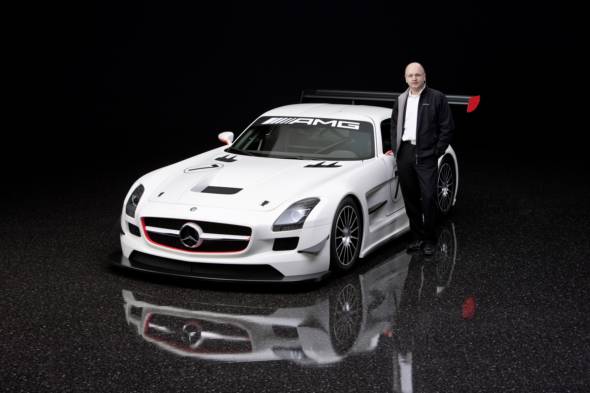








The new Mercedes-Benz SLS AMG GT3
Thoroughbred motor sports technology for the racetrack

Automotive fascination combined with spectacular racing car design – the new Mercedes-Benz SLS AMG GT3.
This racing version of the gullwing mo-del was designed as customer sports car for competing in race series accord-ing to the near-series FIA GT3 rulebook.
Outstanding handling dynamics are ensured by uncompromising lightweight construction and specific modifica-tions to the suspension, brakes and aerodynamics.
This very special gull-wing model will deliver its debut performance on the racetrack in 2011.

The purist design and breathtaking contours of this gullwing model are effec-tively emphasised by specific modifications to the bodywork.
The new compo-nents made mainly from carbon-fibre are an unmistakable testimony to the out-standing racetrack performance and extensive aerodynamic development work.
At the front the GT3 racing car has a new front apron with larger air intakes: the wide aperture below the characteristic radiator grille with a large Mercedes star and a wing-shaped transverse fin supplies the engine oil cooler and brake discs with cooling air.
The two air intakes below the vertically arranged bi-xenon head-lamps have the same function.
Downforce at the front axle is provided by four ex-ternally mounted “flics” and the carbon-fibre front splitter: this blends into the smooth underbody cladding which ends with the rear diffuser.

The bonnet has a central aperture to dissipate the engine heat. The hot air is ven-ted in the wheel arches from side vents in the front wings.
Particularly light-weight polycarbonate is used to glaze the side and rear windows, and this is also available for the windscreen.
The front and rear wings have been widened to make space for the large racing tyres.
With a width of 1990 millimetres, the body of the GT3 is a good 50 millime-tres wider than that of the standard SLS AMG. The new side skirts have apertures

for cooling the rear brakes. The smooth underbody is visible at the lower edges of the side skirts.
The standardised filler pipe for the fast-refuel system is accom-modated in the B-pillar. The 120-litre fuel tank is centrally located behind the driver.
Wide rear apron of carbon-fibre

Viewed from the rear, the SLS AMG GT3 impresses with its sheer width. The boot lid is surmounted by a wide carbon-fibre rear aerofoil, which has multiple ad-justments and allows a perfect setup for the type of racetrack concerned.
The new rear apron features two apertures designed to vent the rear wheel arches.
The car-bon-fibre rear diffuser is another eye-catching feature: as an extension to the smooth underbody, it gradually rises in the rear axle area and generates a down-force thanks to its shape.
The overall aerodynamic concept of the SLS AMG GT3 was refined and finalised in extensive wind tunnel and racetrack tests.

The black exhaust tailpipes emit a thrilling and very characteristic AMG eight-cylinder sound.
The rain light prescribed by the rulebook is integrated into the boot lid – it must remain permanently switched on if the weather conditions are poor.
Near-series AMG 6.3-litre V8 engine
As prescribed by the FIA GT3 rules, the AMG 6.3-litre V8 engine is practically i-dentical to that in the standard model.
Thanks to its lower weight, the GT3 will easily better the already outstanding acceleration of the standard model – 3.8 seconds from zero to 100 km/h; depending on the final drive ratio, the top speed will exceed 300 km/h.

The AMG 6.3-litre V8 engine also has a dry sump lubrication system in the racing model. Using vacuum and pressure pumps, as well as an external oil tank, makes it possible to dispense with a conventional sump.
This technology ensures reliable engine lubrication even under the high lateral acceleration forces encountered on the racetrack.
Dry sump lubrication also allows a low installed position for the V8 engine – one of the key technological highlights of the SLS AMG.
Installing the eight-cylinder engine in the lowest possible position behind the front axle as a front-mid engine, and combining it with the transmission in a transaxle arrangement, produces a very favourable weight distribution.

Six-speed racing transmission with sequential gear-changes
Unlike in the standard model, power in the SLS AMG GT3 is transferred by a six-speed racing transmission with sequential gear-changes.
Thanks to its compact construction, this race-tested transmission has advantages in terms of packaging – after all, the GT3 version has a smaller ground clearance than the standard mo-del.
The driver shifts the gears using two shift paddles on the steering wheel. The transmission is mounted directly on the rear axle, and connected to the V8 en-gine via a flexurally and torsionally rigid torque tube.

This has decisive advan-tages with respect to handling dynamics, as this sophisticated solution enables the entire powertrain to be configured with far less free play.
In conjunction with the traction control sysem, a multi-disc locking differential integrated into the transmission ensures outstanding acceleration.
A drive shaft rotates at the engine speed within this torque tube. As in the standard model, and also the Mercedes-Benz C-Class DTM racing cars, the shaft is made from carbon-fibre.
The vehicle concept of the SLS AMG is predestined for top-class racetrack perform-ance, with a long wheelbase, a low centre of gravity and a wide track. Its strengths include precise over/understeer characteristics, first-class agility, low inertia during fast changes of direction and high physical limits when cornering.

Very few modifications were required for perfect racetrack performance: the low-ered, lightweight aluminium suspension with double wishbones all-round has the ideal kinematics.
Multiple adjustments allow the best possible adaptation to the relevant racetrack characteristics and prevailing weather conditions.
Not only the spring and damper setups, but also the track width and camber, the suspension height and the stabilisers at the front and rear axles can be adjusted.

The rack-and-pinion steering system with speed-sensitive servo assistance is ba-sically the same as in the standard SLS AMG.
The more direct steering ratio makes for even more agile handling on the racetrack.
AMG motor sports braking system with composite technology
The AMG motor sports braking system ensures extremely short braking dis-tances, outstanding fade-resistance and great sensitivity: race-tested composite technology is used for all the brake discs.
In this system, the grey cast-iron discs are mounted on an aluminium bowl via stainless steel connections in a radially and axially floating arrangement.
This sopisticated technology allows perfect heat conduction, and therefore reliable fade-resistance.
The SLS AMG GT3 also fea-tures precisely configured cooling ducts: apertures in the front apron and in front of the rear wheels supply the brake discs with cool air when on the move.

All four brake discs are ventilated, grooved and perforated. Six-piston fixed calipers at the front and four-piston fixed calipers at the rear in anthracite with a white AMG lo-go allow generous brake lining surfaces.
An anti-lock braking system with a spe-cial racing configuration is standard.
For space reasons, the AMG high-performance ceramic composite braking system optionally available for the stan-dard model is not compatible with the 18-inch wheels prescribed by the FIA rule-book.

The size 12 x 18-inch (front) and 13 x 18-inch (rear) AMG light-alloy wheels with central locking are shod with racing tyres in size 287 x 682 mm (front) and 315 x 708 mm (rear).
Depending on the conditions, untreaded slicks, intermediates or rain tyres are used. The classic multi-spoke design assists ventilation of the braking system.
Rapid pitstops and wheel-changes are assured by the pneumatic jack-ing system integrated into the underbody: four pneumatic jacks lift the GT3 rac-ing car by around 190 millimetres to allow very rapid wheel-changes by the pit crew.
Interior with racing bucket seat and racing steering wheel
Opening the gullwing doors of the SLS AMG GT3 reveals a functional
interior with a racing car atmosphere. The driver is seated in a racing bucket seat, his safety assured by a six-point seat belt and the HANS system (Head and Neck Support), which fixes his helmet in a defined position during an accident to mi-nimise the risk of injury.
Additional safety is provided by the steel rollover cage, which also serves to reinforce the aluminium spaceframe.

A racing steering wheel with a diameter of 330 millimetres allows perfect vehicle control.
Thanks to the open upper section of the rim, the driver always has a clear view of the central display.
This keeps him informed about all the relevant parame-ters such as speed, engine rpm, operating temperatures, lap times and the selected gear.
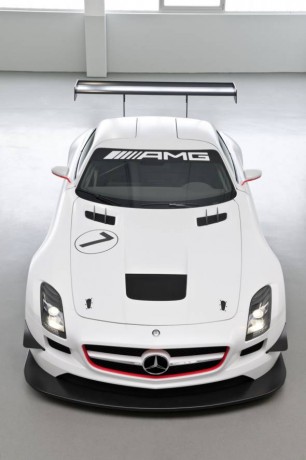
The steering wheel also has a quick-locking feature which allows much easier access and egress.
Switches on the steering wheel boss enable the driver to activate additional functions such as the radio link to the pits, headlamp flasher or the drink function.
Further controls are mounted on the centre console, for example the start/stop function for the AMG V8 engine, the traction control system, reverse gear and – if the worst should happen – the integrated fire extinguisher system.
The brake balance adjustment control is mounted on the tunnel of the torque tube.

The near-series specification of the GT3 version is reflected in the dashboard, whose powerfully arching wing section gives an impression of width.
Strikingly integrated into the dashboard, the air vents galvanised in “Silver Shadow” have adjustable, cruciform nozzles reminiscent of an aircraft’s jet engines.
Deliveries of customer vehicles will commence in spring 2011

The new SLS AMG GT3 was developed to comply with the international FIA GT3 race rules, and is entitled to take part in all GT3 race series – which of course in-cludes the popular 24-hour race in Spa-Francorchamps (Belgium) or the Nürburgring.
Interested customers are able to order the GT3 from autumn 2010, and de-livery will take place in time for the start of the 2011 racing season. Homologation will be completed in March 2011.
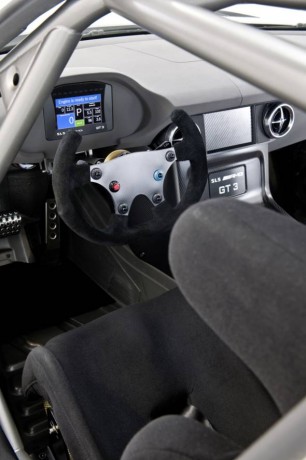
At a glance: technical highlights* of the new Mercedes-Benz SLS AMG
| Aluminium spaceframe: this design realised for the first time by Mercedes-Benz combines intelligent lightweight construction with great strength – thereby supporting the outstanding driving dynamics of the SLS AMG. The bodyshell weighs a mere 241 kilograms.
| Standard |
| Adaptive front airbags: the front airbags can deploy in two
| Standard |
| Aerodynamic balance: the SLS AMG combines optimum
| Standard |
| AMG alubeam silver: this new process – a world first – makes the paint finish shine like liquid metal, with specific light reflections that give even more life to the painted surface. Thius effect is made possible by microscopic, 30 to 50-nanometer small
| Optional |
| AMG DRIVE UNIT: integrated into this are the rotary control for the transmission modes, the engine starter button and keys for the ESP® functions, the AMG memory function and the extendable rear aerofoil.
| Standard |
| Bi-xenon headlamps: gas-discharge lamps for low and main beam improve safety at night.
| Standard |
| Carbon-fibre drive shaft: as in the Mercedes-Benz C-Class DTM racing touring cars, the drive shaft is of carbon-fibre. Although the shaft has to transfer 650 newton metres of torque from the engine to the double-declutch transmission, it weighs only
| Standard
|
| Differential lock: the mechanical multi-plate differential lock ensures improved traction in any road conditions.
| Standard |
| Diffusor: integrated into the rear bumper, the diffusor directs
| Standard |

The interior of the Mercedes-Benz SLS AMG
Lightweight construction, dynamism and emotion: swing-wing design with a puristic super-sports car interior
New York/Affalterbach – For the new SLS, Mercedes-Benz and AMG have developed a puristic sports car interior that combines lightweight construction with dynamism and high emotional appeal.
Opening the unique swing-wing doors reveals an interior of a decidedly sporty nature – and immediately brings an aircraft cockpit to mind.

The central design theme of “aviation engineering” is reflected in the wing-shaped dashboard, the centre console in the style of a jet’s operating console and the four striking air vents reminiscent of aircraft engines.
The interior of this new swing-wing car offers authentic motor sports practicality, the safety typical of a Mercedes and outstanding ergonomics.
Fine materials such as nappa leather, solid metal and (optionally) genuine carbon-fibre facings underline the pronounced “custom-built” nature of the SLS interior, and show enormous attention to detail.

“The interior of the new Mercedes-Benz SLS AMG is not only very special because of the exclusive swing-wing doors.
The visible influence of aviation engineering, the high-grade materials and the practicality typical of a sports car will make the hearts of sports car enthusiasts beat faster.
At the same time the new interior styling indicates the design philosophy for coming generations of Mercedes sports cars”, says Gordon Wagener, Head of Design at Mercedes-Benz.
Sport, purism, reduction and authenticity are the design emphases for the interior of the new Mercedes-Benz SLS AMG.
But above all the design is influenced by the world of aviation – which is clearly demonstrated by the new swing-wing. The characteristic styling feature is the dashboard, whose powerful and dramatic wing-

shape makes for an impression of width. The four air vents with their adjustable, cruciform nozzles are reminiscent of a jet’s engines.
An aircraft cockpit is also the visual and practical design inspiration for the long “Silver Shadow” centre console in solid metal, in which all the central controls including the AMG DRIVE UNIT, which is inclined towards the driver, are consolidated.
On request the centre console and other features are also available in carbon fibre. As a new feature, the E-SELECT shift lever controls the AMG SPEEDSHIFT DCT 7-speed sports transmission on the drive-by-wire principle.
Its shape immediately calls the thrust control of a jet aircraft to mind, and the same applies to the concave inner panels of the swing-wing doors.
The high waistline reinforces the cockpit-like impression, while imparting a feeling of safety and security at the same time.

All the controls are ergonomically grouped around the driver, easy to reach and intuitive to operate. In this respect too, the interior of the SLS is reminiscent of an aircraft cockpit.
The logically conceived control and display concept follows well-proven Mercedes principles, easy identification of the major functions and rapid access to frequently used functions being the major attributes.
Interior with an authentic “custom-built” character
Electrically adjustable sports seats with integrated head restraints ensure excellent lateral support and a high level of comfort on long journeys.
The AMG Performance leather steering wheel in a three-spoke design has a 365-millimetre rim with a flattened lower section, shift paddles and a metal insert, underlining the authentic custom-built look in the same way as the attractive instrument cluster.

As standard equipment the SLS features hand-stitched designo leather with a contrasting seam on the dashboard, sports seats, interior door panels and armrests.
Comfort and convenience features include THERMOTRONIC, cruise control with SPEEDTRONIC, PARKTRONIC, a rain sensor, Headlamp Assist and KEYLESS-GO.
Even more onboard comfort is ensured by optional extras such as the newly developed Bang&Olufsen sound system, designo Exclusive leather, a DVD changer, the Media Interface and the Interior Carbon package.

The best possible passive safety for the occupants is ensured by three-point seat belts, belt tensioners, belt force limiters and eight airbags: two adaptive airbags and a kneebag each for the driver and passenger, plus two sidebags integrated into the seats for maximum occupant protection and two separate windowbags that deploy from the door waistline.
The new Mercedes-Benz SLSAMG will celebrate its market launch in spring 2010.
Technical details and appointments
Perfectly tailored for two. The low seating position typical of a sports car, perfect ergonomics and great functionality were the very demanding parameters when developing the interior of the new Mercedes-Benz SLS AMG.

A seating height of only 369 millimetres above the road surface guarantees that typical sports car feeling.
At the same time the intentionally steep angle of the windscreen ensures good all-round visibility.
The feeling of comfortable spaciousness is in large measure due to the generous shoulder-room of 1483 millimetres and elbow room of no less than 1606 millimetres.
In conjunction with the generous maximum headroom of 990 millimetres and effective legroom for the driver of 1058 millimetres, the result is a low but extremely relaxed seating position.

Wide-opening swing-wing doors for easy entry even in garages
One important criterion for customer satisfaction is ease of access and egress through the exclusive swing-wing doors.
At the design stage great attention was paid to the widest possible opening angle – it is a full 70 degrees.
Equally importantly, the distance between the open doors and the road surface is a generous 1.50 metres, while the entry aperture between the open doors and the upper edge of the door sills measures no less than 1.08 metres.
The entrance height, i.e. the distance between the road surface and the door sills is a very low 45 centimetres.
As another important criterion for dignified access and egress, two gas-pressure struts positioned next to the door hinges require only very little pressure when opening and closing the doors – even at very low ambient temperatures.
The swing-wing doors require less opening space than conventional coupé doors, and can be fully opened in a normal garage.
The door is opened from inside by a handle finished in Silver Shadow. The grip section of the armrest moulded into the interior door panel ensures problem-free door closing even for small passengers.
The operating keys for the power windows, central locking system and exterior mirror adjustment are also located in the interior door panels for easy access.
Electrically adjustable sports seats with magnesium backrests
The sports seats with integrated head restraints feature so-called two-zone seat cushions.
Prominent side bolsters with a harder foam filling provide optimal lateral support, while the inner areas of the seat cushion and backrest are softer for a high level of comfort on long journeys.
The backrests are made from magnesium, a high-tech material that combines light weight with high strength. This leads to significant advantages where weight distribution and a low centre of gravity are concerned.
The fore-and-aft position, seat height, backrest angle, seat depth, squab angle and steering column are electrically adjustable, and the side bolsters and lumbar support can also be adjusted.
The Memory package allows three individual configurations to be stored. Three-stage seat heating and seat occupany/child seat recognition in the passenger seat are also standard equipment.

The adjustment range of the Performance steering wheel is 60 millimetres axially and 2.3 degrees upwards or downwards – this applies to both manual and electrical adjustment.
The 365-millimetre, leather-covered steering wheel features a high-quality full metal insert and a flattened lower rim section whose specially formed cross-section ensures the best possible vehicle control.
Metal shift paddles are used to shift the seven gears of the double-declutch transmission. A brief pull on the left (–) or right (+) shift paddle is enough to engage the next gear.
Multifunction keys in the left and right steering wheel spoke allow rapid access to the audio, telephone and navigation functions, as well as the LINGUATRONIC voice-operated control system.
The main manu in the instrument cluster can also be accessed using the ergonomically designed steering wheel keys.
The rotary light switch and the keys for the electric parking brake and remote boot lid opening function are located to the left of the Performance sports steering wheel.
AMG DRIVE UNIT with new E-SELECT lever
One of the visual and functional highlights in the interior of the SLS is the solid centre console, which immediately calls an aircraft cockpit to mind.
All the central control functions including the AMG DRIVE UNIT, which is inclined towards the driver, are grouped on this striking, solid-metal feature also optionally available in genuine carbon fibre.
The new E-SELECT shift lever for the 7-speed sports transmission also has a jet aircraft look: the one-touch drive-by-wire system enables the driver to shift between P, R, N and D extremely rapidly.
When the car is stationary, simply pressing the P-key activates the parking position – this also happens automatically when the engine is switched off.
To the left are the rotary controls for the transmission’s driving modes, including RACE START, as well as the keys for engine starting, the ESP® functions, the AMG memory function and the extendable rear aerofoil.
The instrument cluster provides a wealth of information
The instrument cluster is ideally located in the driver’s field of vision. The two dial instruments provide information about the vehicle speed and engine speed, and have two small, integrated displays showing the fuel level and the engine oil temperature.
When the ignition is switched on, the needles of the rev counter and speedometer simultaneously spin around to their maximum position, then instantly return to zero.
Between the dial instruments there is a 4.5-inch central display for information such as the odometer reading, range, fuel consumption, trip mileage, driving time and average speed.
The AMG main menu not only shows the tyre pressure for each wheel, but also has three modes providing comprehensive driver information: “Warm Up”, “Set Up” and “RACE”. Warm Up shows the coolant and transmission oil temperature,
Set Up shows the currently selected ESP® mode. Race activates the RACETIMER, which enables the driver to measure lap times on the racetrack.
All the functions of the central display can be conveniently operated via the multifunction keys in the steering wheel.
Permanently active displays not only include the current gear and the driving mode “C” (Controlled Efficiency), “S” (Sport), “S+” (Sport plus) or “M” (Manual) of the SPEEDSHIFT double-declutch transmission, but also the clock, ambient temperature or digital speed.
The information from the navigation system, audio functions and telephone, individual vehicle settings and the ASSYST PLUS service interval display can also be accessed in the central display.
Bang&Olufsen sound system available on request
The centre console is also desgned with the best possible ergonomics in mind. The upper section has an array of keys for the COMAND APS multimedia system.
All the functions of the radio, DVD player, telephone and navigation system can be controlled from here.
When switched on, the 7-inch colour display in the dashboard shows the unmistakable AMG logo for ten seconds – and depending on the function, a high-resolution map or other information such as the radio station, music track or telephone keypad.
The Europe-wide navigation system has a 30‑gigabyte hard disc on which the navigation data are stored, which means that route calculation is extremely rapid.
The car radio with integrated CD/DVD player features an FM/MW/SW and LW twin tuner with automatic station search, RDS, a 4 x 25 watt amplifier and a total of 6 loudspeakers.
In addition, COMAND APS includes a music server with a memory capacity of 6 gigabytes, which enables the driver to store up to 1000 music files.
A DVD player for video and audio is also on board, and an integrated 6-disc DVD changer is available on request.
Below the DVD aperture the unit has an adapter that enables various PC memory cards for the reproduction of music files to be used.
External audio devices such as an “iPod” can be connected to COMAND APS via the optional Media Interface.
The new sound system realised by Mercedes-Benz and AMG together with the famous Danish audio specialist Bang&Olufsen was developed specifically for the SLS.
The surround-sound system with Dolby Digital 5.1 provides an exclusive listening experience at the highest level.
This is not only thanks to the amplifier with a total output of 1000 watts and 11 loudspeakers, but also to the sound processor’s precise distribution of the music signals to selectable driver, passenger or central positions.
The digital sound processor (DSP) also makes it possible to choose between a high-end studio sound (“Reference”) and surround-sound.
All the functions are controlled via a special Bang&Olufsen menu in COMAND APS.
Particular highlights are provided by the two 250-watt subwoofers integrated into the parcel shelf and the illuminated 50-watt tweeters on the dashboard.
The Controller directly integrated into the centre console operates the mutimedia system COMAND APS.
This turn/push control can be moved in seven directions: turning the controller selects the main menu and submenus on the display, while pushing it activates or confirms the displayed function or setting.
The buttons next to the Controller marked with “R” and “C” symbols are used to quit submenus quickly or delete entries.
THERMOTRONIC comfort automatic climate control as standard
Where climatic comfort is concerned, the new swing-wing sports car likewise meets the high expectations that await a super-sports car from Mercedes-Benz and AMG.
The sophisticated THERMOTRONIC two-zone comfort automatic climate control system is included as standard.
A powerful air conditioning compressor ensures rapid cooling of the interior; the cooled air flows from the four multi-adjustable vents in the dashboard, two apertures in the A-pillars, three on the windscreen and one in each footwell.
Sensors constantly monitor the interior temperature, the temperature of the air flowing from the air vents, the air moisture content and the intensity and angle of the sun.
A pollutant sensor recognises excessive carbon monoxide and nitrogen oxide concentrations in the outside air, and automatically closes the air recirculation flap if levels of these pollutants increase rapidly.
The interior of the SLS also impresses with the practical stowage space that makes for the day-to-day suitability typical of a Mercedes.
The 3.7-litre glove compartment with a spectacles compartment is integrated into the dashboard on the passenger side.
To the right of the E-SELECT shift lever there is a small stowage compartment with a 12 V socket, or an ashtray with cigar lighter.
The armrest behind the centre console not only serves for Controller operation: at the touch of a button, the armrest can be moved in two stages to reveal a stowage compartment underneath.
This has two cupholders and the telephone cradle (optional), and a holder for the ignition key in the rear section.
Other items can be stowed on the rear wall between the seats and in the parcel net in the passenger footwell.
Two fixed clothes hooks are attached to the seat backrests, while those in the roof lining fold down and are silicon-insulated.
Eight airbags meet the highest standards in passive safety
The very latest restraint systems meet the traiditionally high standards of Mercedes-Benz where passive safety is concerned.
Three-point seat belts with belt tensioners and belt force limiters are provided as standard for occupants of the Mercedes-Benz SLS AMG.
These are complemented with eight airbags: two adaptive airbags for the driver and passenger, a kneebag for each, two seat-integrated sidebags and two separate windowbags deploying from the waistlines of the swing-wing doors.
Overview of the comprehensive standard equipment (selection):
· AMG entry sills painted in the vehicle colour
· Cord floor mats with AMG logo
· Burglary and theft warning system
· Electric parking brake
· Headlamp Assist
· KEYLESS-GO
· designo leather upholstery
· PARKTRONIC
· Rain sensor
· Heated seats
· Sports pedals in brushed stainless steel with black rubber studs
· Cruise control with SPEEDTRONIC
· THERMOTRONIC
Optional extras include the following:
· Bang&Olufsen sound system
· DVD changer
· Anti-theft warning system
· Electric seat adjustment with Memory package
· Interior Carbon package
· designo Exclusive leather
· Media Interface
· Seats in natural leather/woven leather




 To select “Sport” mode the key in the AMG DRIVE UNIT is pressed once. The left control lamp in the key and the AMG main menu display tell the driver that “Sport” mode has been manually activated. In “Sport” mode the shock absorbers have a tauter response depending on the driving situation, which not only ensures better road contact when driving in a sporty manner, but also more effectively reduces body roll and pitching.
To select “Sport” mode the key in the AMG DRIVE UNIT is pressed once. The left control lamp in the key and the AMG main menu display tell the driver that “Sport” mode has been manually activated. In “Sport” mode the shock absorbers have a tauter response depending on the driving situation, which not only ensures better road contact when driving in a sporty manner, but also more effectively reduces body roll and pitching.




The current vehicle speed, wheel rotation speeds and selected gear ratios are also continuously analysed. High-performance control electronics in permanent dialogue with the engine and transmission control unit ensure that the forces of the four newly developed shock absorbers are adapted practically instantly.



The new, optionally available Blind Spot Assist is able to increase active safety. This visual and acoustic warning system uses the close-range radar sensors of the standard PARKTRONIC system to recognise vehicles in good time where visibility is restricted.

Available as an optional extra, the car’s visual appearance is enhanced by weight-optimised AMG 10-spoke forged wheels shod with tyres in size 265/35 R 19 (front) and 295/30 R 20 (rear).

- AMG RIDE CONTROL sport suspension with adaptive damping: kr 19,893 ()
- AMG 10-spoke forged wheels with matt black paint finish and high-sheen rim flange: kr 28,054 ()
- Red-painted brake callipers: kr 6,123 ()
- Blind Spot Assist: kr 6,631 ()
- AMG Sepang brown metallic: kr 20,913 ()
- AMG high-gloss black trim: kr 19,889 ()


